This is the website of Abulsme Noibatno Itramne (also known as Sam Minter).
Posts here are rare these days. For current stuff, follow me on Mastodon
|
States with new poll data added since the last update: All 50 states, plus the Maine congressional districts. Notable changes caused by Colorado, Florida, Missouri, New Hampshire, Maine (CD2), and South Carolina.
There were a ton of changes with this batch of new polls. Four of the changes favored Trump, two favored Clinton. We’ll look at each of these in order. The “good for Trump” states first, then the “good for Clinton” states, then we’ll review the net national changes due to all of these together.
Good for Trump
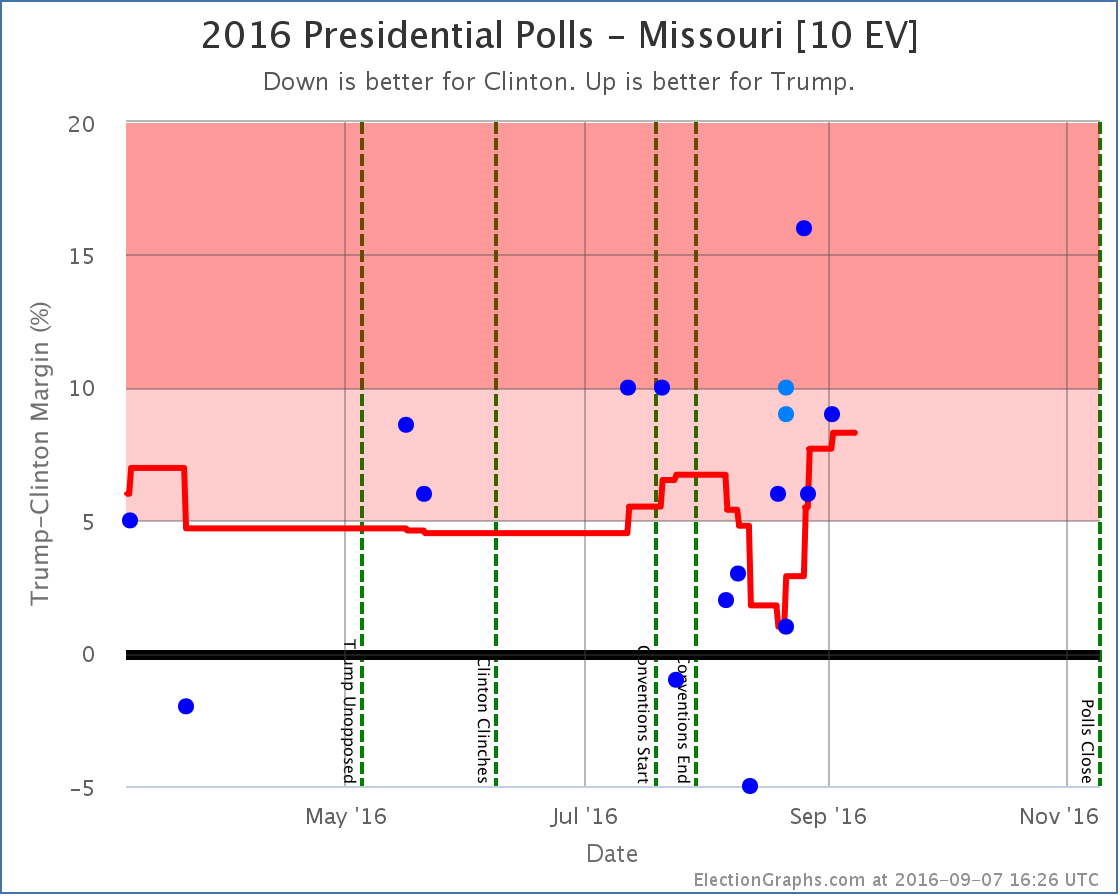
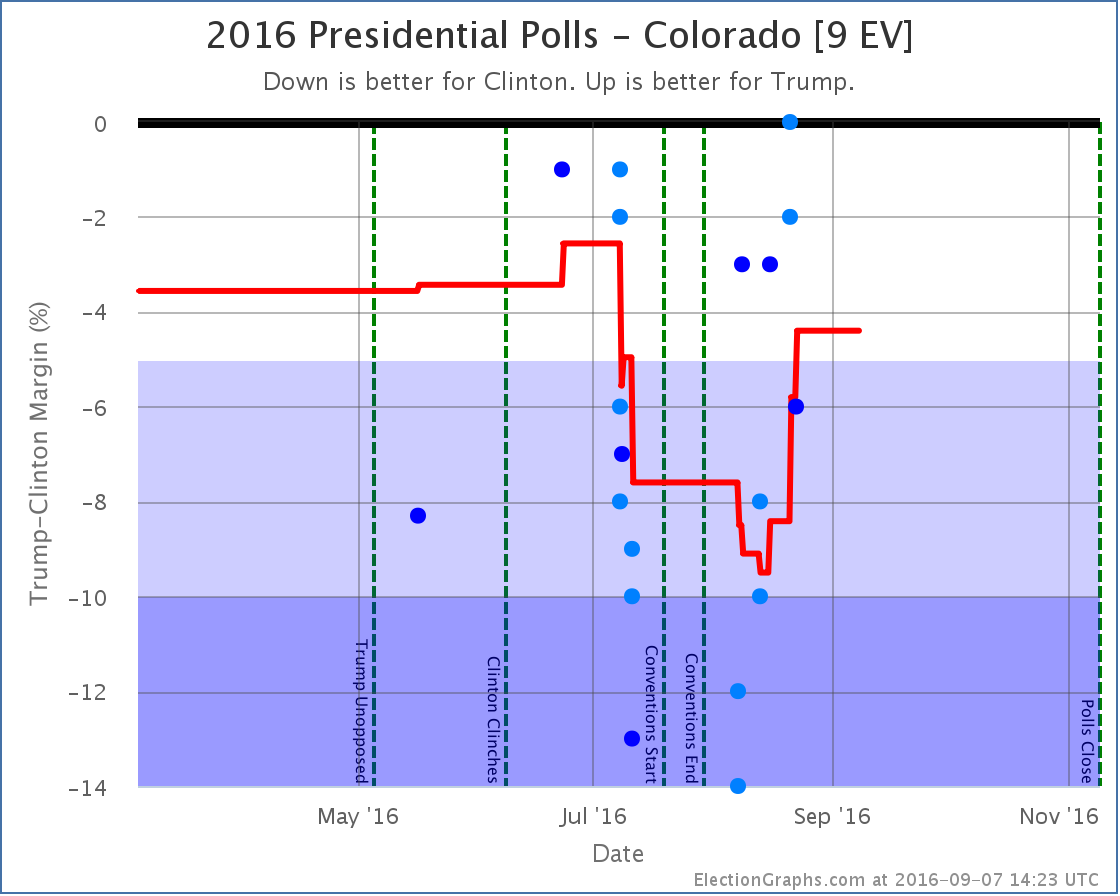
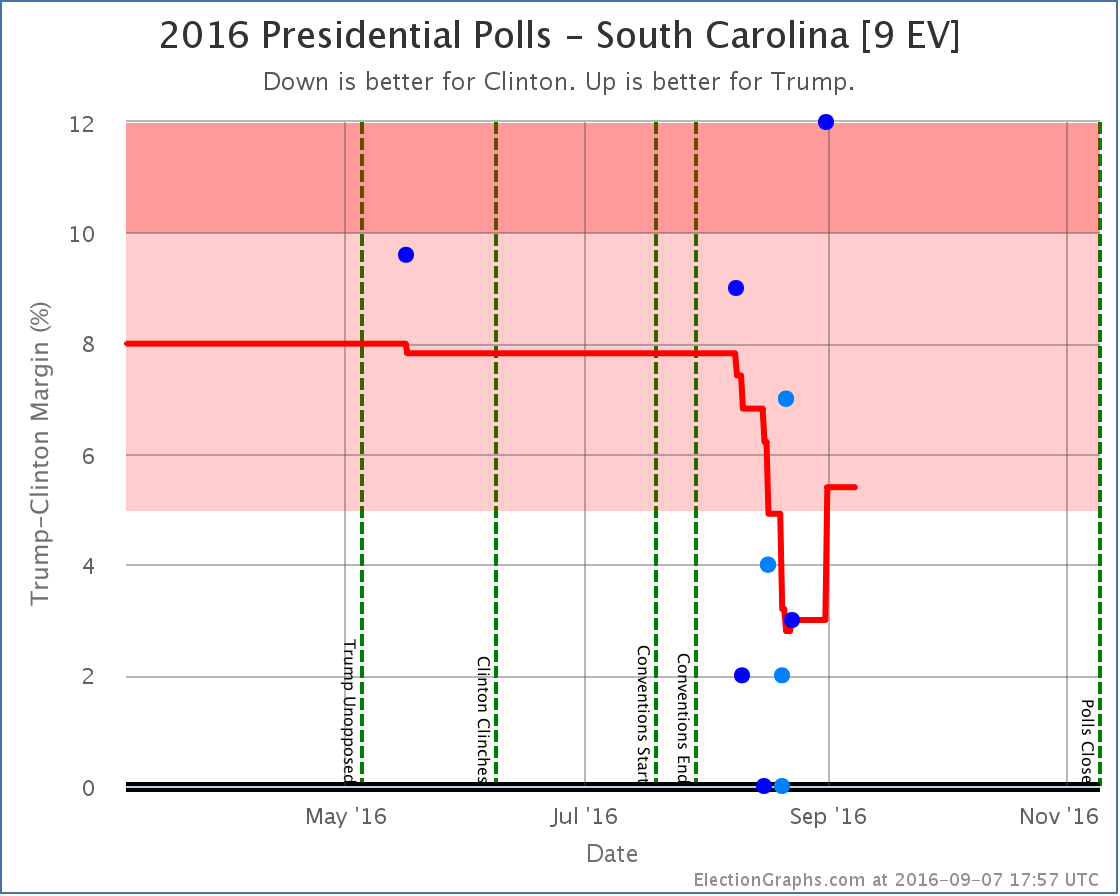
Missouri, Colorado and South Carolina all show the same general pattern… a Trump decline bottoming out in mid-August, followed by a Trump recovery. The specifics of the patterns are slightly different, but the dip followed by a rebound looks clear. (Although the rebound in South Carolina may turn out to be due to an outlier.)
Missouri and South Carolina had looked like states where Clinton was making it close, Trump now pulls them out of reach again. Meanwhile Clinton’s lead in Colorado looked like it was not at risk for her, but the last few polls show Trump making it close again.
So winning Missouri and South Carolina are no longer part of Clinton’s best case, while the possibility of winning Colorado is now included in Trump’s best case.
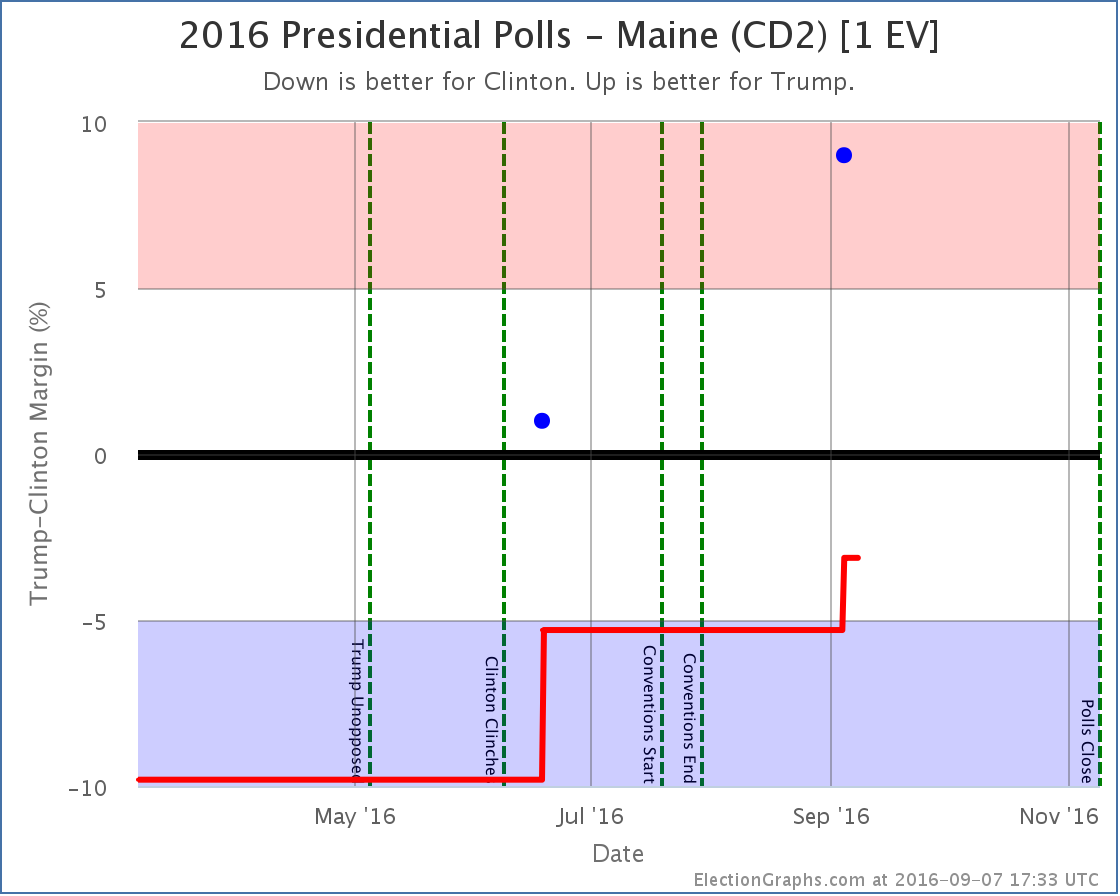
Maine and Nebraska are the only two states that can split their electoral votes. So far Nebraska has not been polled at all at the congressional district level. This week brings only the second time the Maine congressional districts have been. In both cases, the overall numbers for the states have moved toward the center line past all of the congressional districts. Mathematically, the state as a whole can’t be closer than all the parts making up the state, so we know this is wrong, but without congressional district polling, we can’t tell where the congressional districts should be.
In Maine, with the new CD2 polling result, we now have two polls showing Trump ahead. These are the only two polls. The average is filled out with the Maine CD2 results from 2004, 2008, and 2012. Given the strong Democratic wins in CD2 in those years, the two polls from this year aren’t quite enough for the poll average to flip the district to Trump, but the average now only has Clinton up by 3.1%, so we now consider Maine’s 2nd District to be a possible pick up for Trump.
Even with this new poll, Maine-CD2 is what I consider to currently be the “most needed poll” (followed by NE-CD2, NE-CD1, SD, and ME-CD1). Please pollsters! More congressional district level coverage of both Maine and Nebraska! They both look like they have a possibility of splitting this cycle. We need more polling to understand just how likely (or not) that possibility actually is!
Good for Clinton
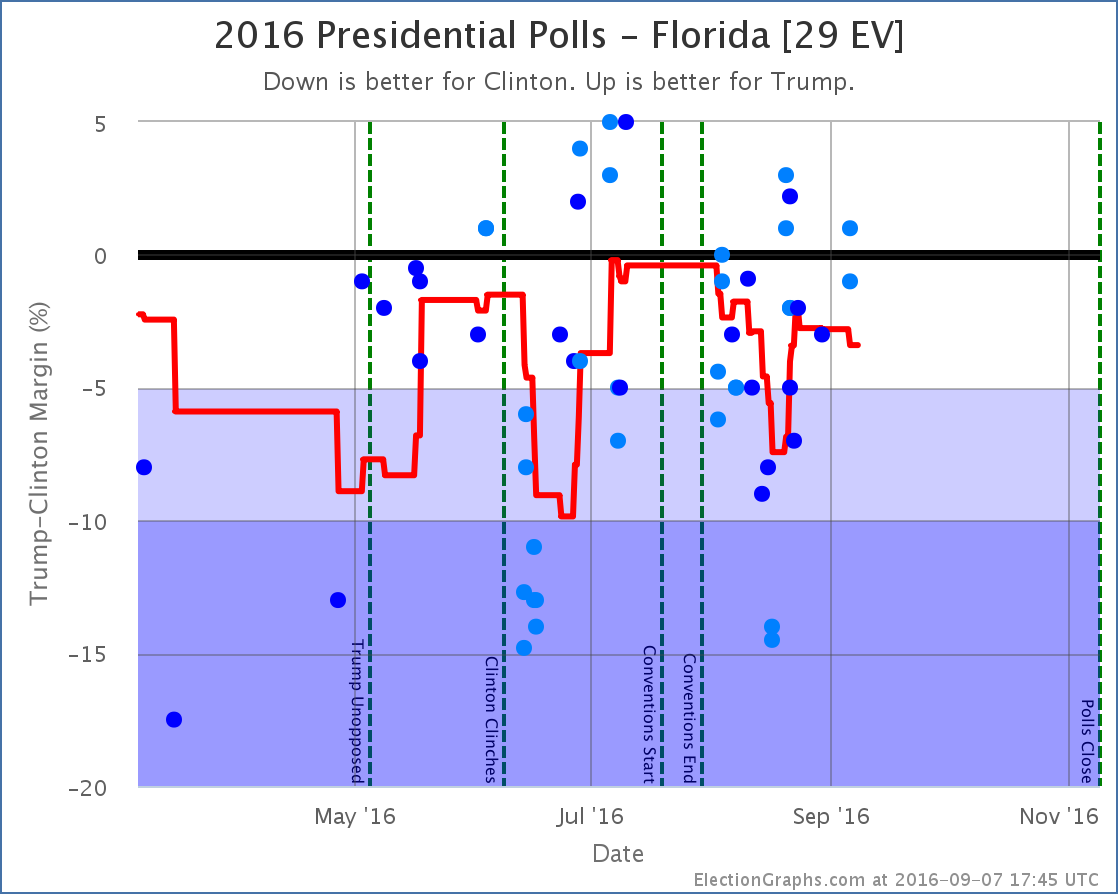
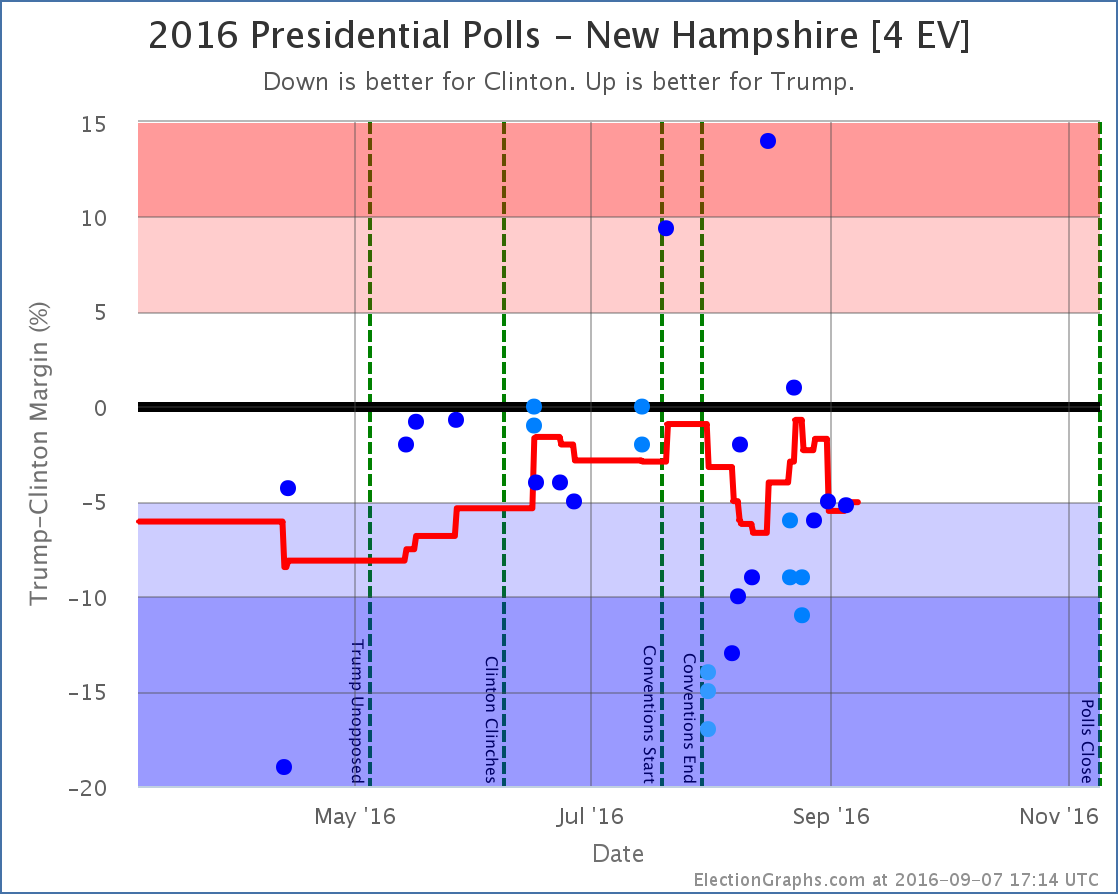
Both Florida and New Hampshire show the typical pattern of the Trump collapse followed by a Trump recovery. But in these two states, Trump peaked and is starting to drop again.
Florida does not change categories, but the change there changes the national tipping point.
In New Hampshire, the average just barely passes our 5% threshold to put the state back in the “Strong Clinton” category, which removes New Hampshire from Trump’s best case. It is right on the line though. Clinton’s lead still rounds to 5.0%. The next poll could easily move this back into “Weak Clinton”.
National View
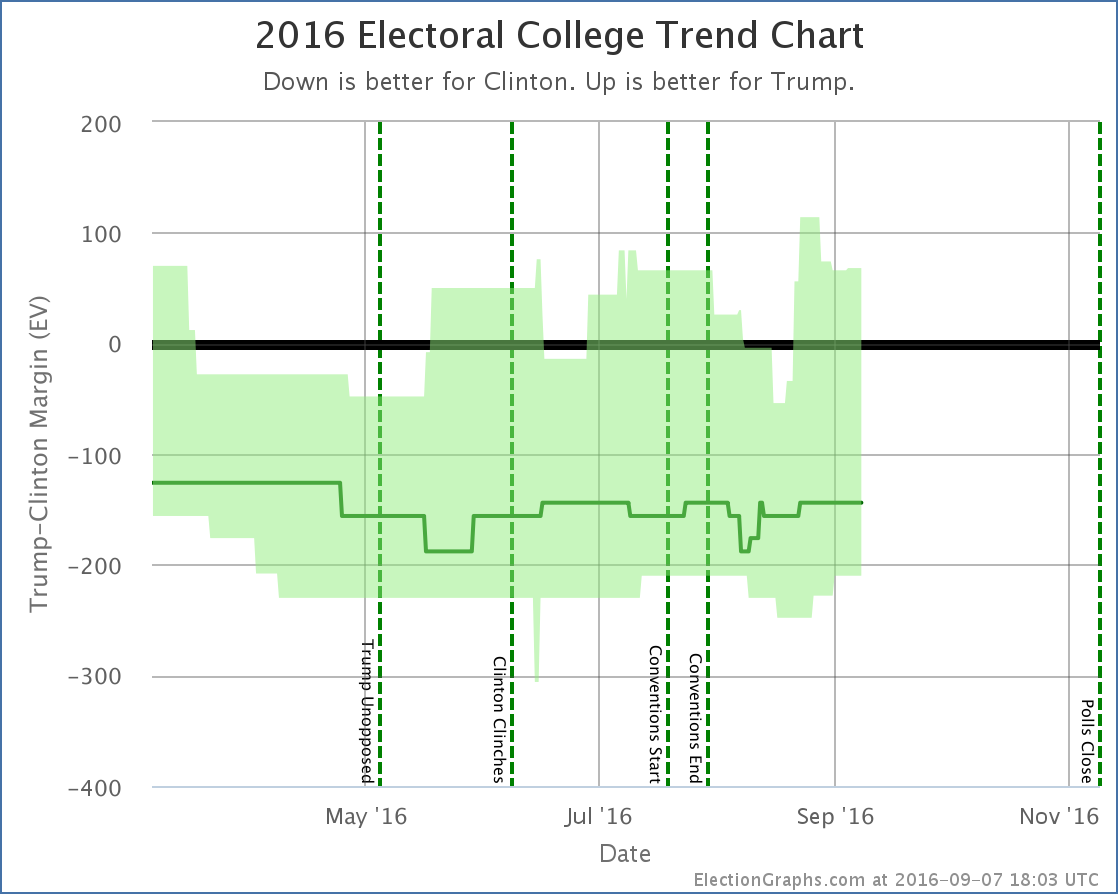
The change from today’s update to Trump’s best case is to move from winning by 56 electoral votes to winning by 66 electoral votes. So net improvement today.
But note the downward trend after August 27th. Even though today’s update was better for Trump, raising the level of the whole graph over the last week or so on the basis of some polls with older midpoints, it does look like his best case may have peaked and is receding a bit now.
Clinton’s best case is receding as well though. It drops in this update from winning by 248 electoral votes to only winning by 210 electoral votes.
And the center line has not shifted. We’re talking about changes in which states are close, not in who is leading where.
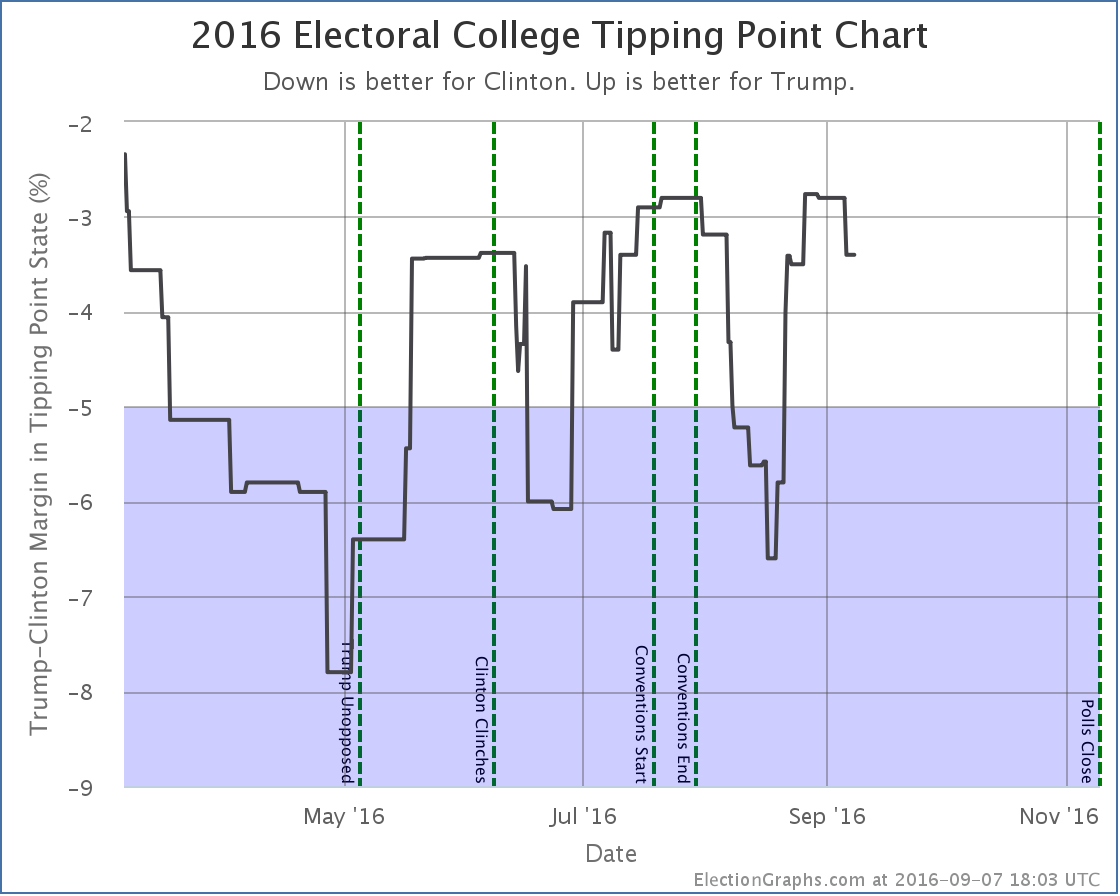
Today’s update moves the tipping point from Clinton by 3.0% in Florida to Clinton by 3.4% in Florida, but you can see that the tipping point peaked a little over a week ago and has been moving toward Clinton, similarly to how Trump’s best case has been moving.
So has Trump really already passed another peak? Is he on a downswing again? Or is this all just reversion to the mean on a race that really is pretty stable? Or does Clinton weakening in the red states she had hoped to pick up mean Trump still has some momentum left?
Stay tuned.
62.1 days until real election results start to come in.
Note: This post is an update based on the data on ElectionGraphs.com. Election Graphs tracks both a poll based estimate of the Electoral College and a numbers based look at the Delegate Races. All of the charts and graphs seen in this post are from that site. Additional graphs, charts and raw data can be found there. Follow @ElectionGraphs on Twitter or like Election Graphs on Facebook to see announcements of updates or to join the conversation. For those interested in individual general election poll updates, follow @ElecCollPolls on Twitter for all the polls as they are added. If you find the information in these posts interesting or useful, please consider visiting the tip jar.
States with new poll data added since the last update: Virginia, Iowa, New Hampshire, Ohio, California, Texas, Pennsylvania, Florida, New York, Illinois, North Carolina, Indiana, Georgia, Missouri, Arizona, Massachusetts, Wisconsin, Tennessee, New Jersey, Minnesota, Washington, Michigan, South Carolina, Maine (All), Louisiana, Utah, Oklahoma, Alabama, Nebraska (All), Oregon, Kansas, Maryland, Kentucky, Mississippi, Nevada, Connecticut, Arkansas, West Virginia, Colorado, Idaho, New Hampshire, Alaska
We have the weekly batch of polls from Ipsos, plus a handful of other scattered polls. One state changes category:
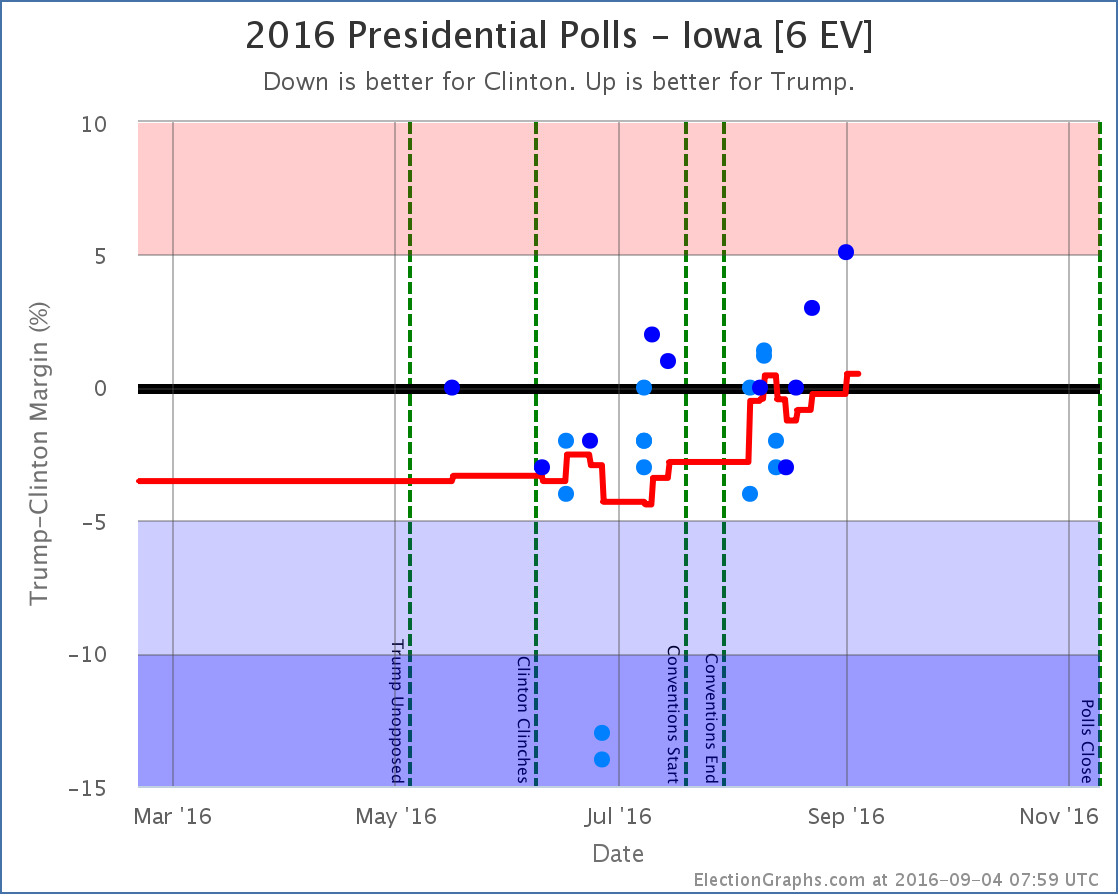
After having been “Weak Clinton” through July, for the last month the average in Iowa has been hovering right around the center line. It had become “Weak Trump” for a short time in the second week of August, but then quickly moved back to Clinton. With the latest couple of polls showing Trump leading, the average moves once again to the Trump side of the line.
This is a narrow lead… 0.5%… it could move back to the other side of the line with the next poll. But for now, Trump leads in Iowa, and so this changes the expected results line:
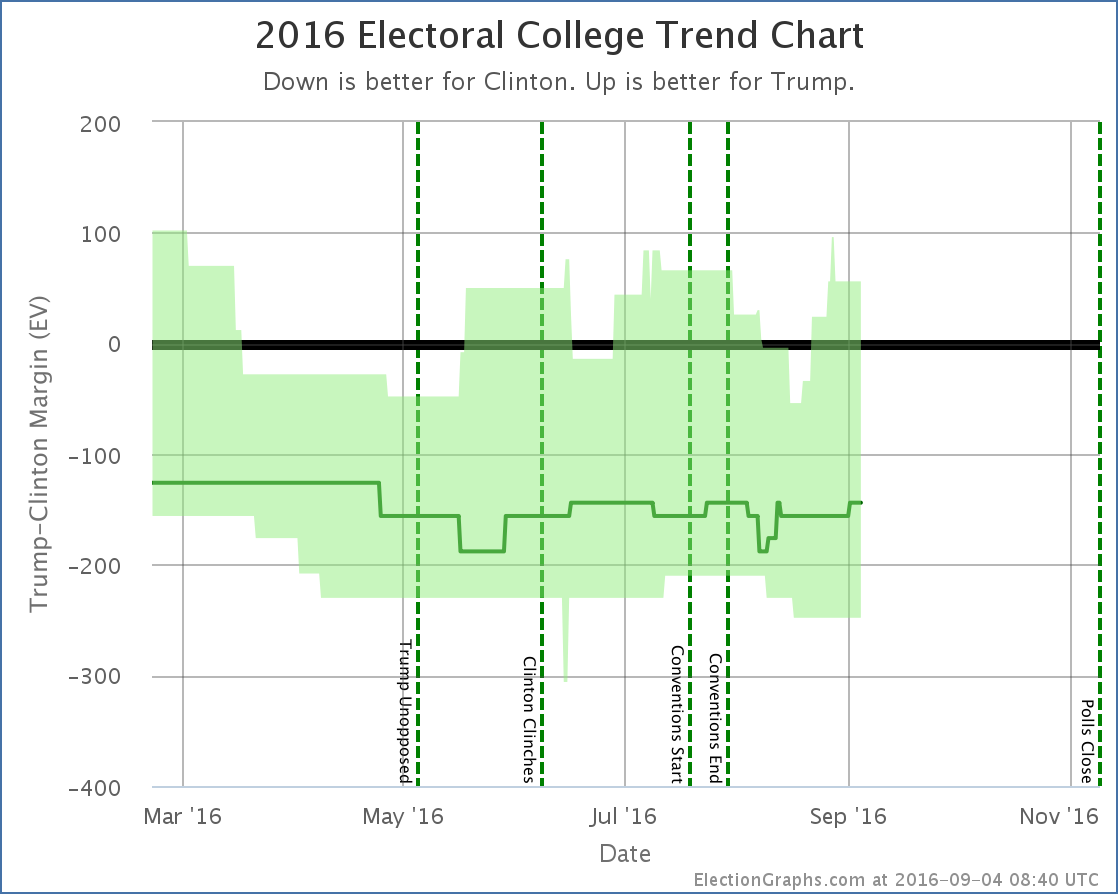
This brings the expected case to a 144 electoral vote win for Clinton. This matches the best Trump has done since April. In terms of the expected case, the metric that actually matters the most, this has seemed like Trump’s ceiling ever since he locked up the nomination. He has been able to move his best case, but in terms of moving blue states over to his side of the line, he just hasn’t been able to push past this level.
With average changes in Ohio and Florida, the tipping point also moved:
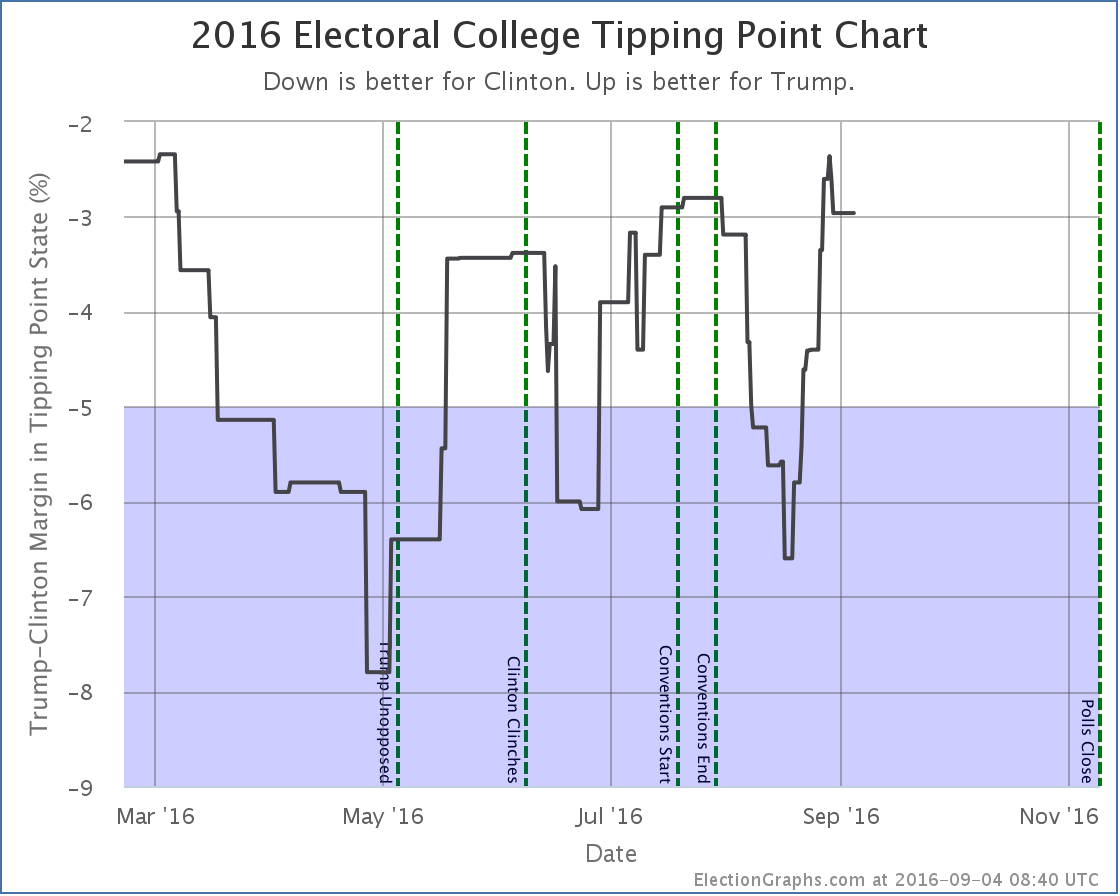
Prior to the current batch of polls, the tipping point was Clinton +3.8% in Ohio. The new polls exposed a brief spike to Clinton only leading by 2.4% in Michigan, but then falling back to Clinton +3.0% in Florida. The net change in this update is still a 0.8% movement toward Trump though.
As with the expected electoral college result, Trump is near the top of his recent range. A 3.0% Clinton tipping point means that only a small uniform shift across all states would push Trump into the lead. The race is actually relatively close here. So why is most of the talk still about how Clinton is clearly winning?
Well, first of all, because she is. Trump has never led in either the electoral college expected case or the tipping point. She is just objectively in the lead and always has been.
Second, we have seen the whole race wiggle around in a zone. Things move up and down within that zone, but seem to have trouble escaping it. On the one side Clinton can’t seem to break out to move things from just a regular comfortable win to doing better than Obama did against McCain, and on the other side, Trump can make the race tighter, but hasn’t been able to break the barrier of matching or improving on Romney’s performance.
Since April, it has looked like Trump would do better than McCain (192 EV loss), but not as well as Romney (126 EV loss). It just seems like that is where this race wants to be, at least in terms of the electoral college. Of course, both of those men lost. This range does not include winning.
So for Trump to win, things need to change and move into a zone they have not been in before. And he is running out of time. The next opportunity will likely be the debates. The first one is in 22 days. Then we have 65.3 days until results start rolling in.
Note: This post is an update based on the data on ElectionGraphs.com. Election Graphs tracks both a poll based estimate of the Electoral College and a numbers based look at the Delegate Races. All of the charts and graphs seen in this post are from that site. Additional graphs, charts and raw data can be found there. Follow @ElectionGraphs on Twitter or like Election Graphs on Facebook to see announcements of updates or to join the conversation. For those interested in individual general election poll updates, follow @ElecCollPolls on Twitter for all the polls as they are added. If you find the information in these posts interesting or useful, please consider visiting the tip jar.
States with new poll data added since the last update: Wisconsin, New York, North Carolina, Pennsylvania, Ohio, Michigan, Virginia, West Virginia, Arizona, New Hampshire, Missouri, Kansas
With the logic change out of the way, the race moves on. With the latest batch of polls, one state changes category, and two more contribute to a change in the tipping point.
Electoral College Trend
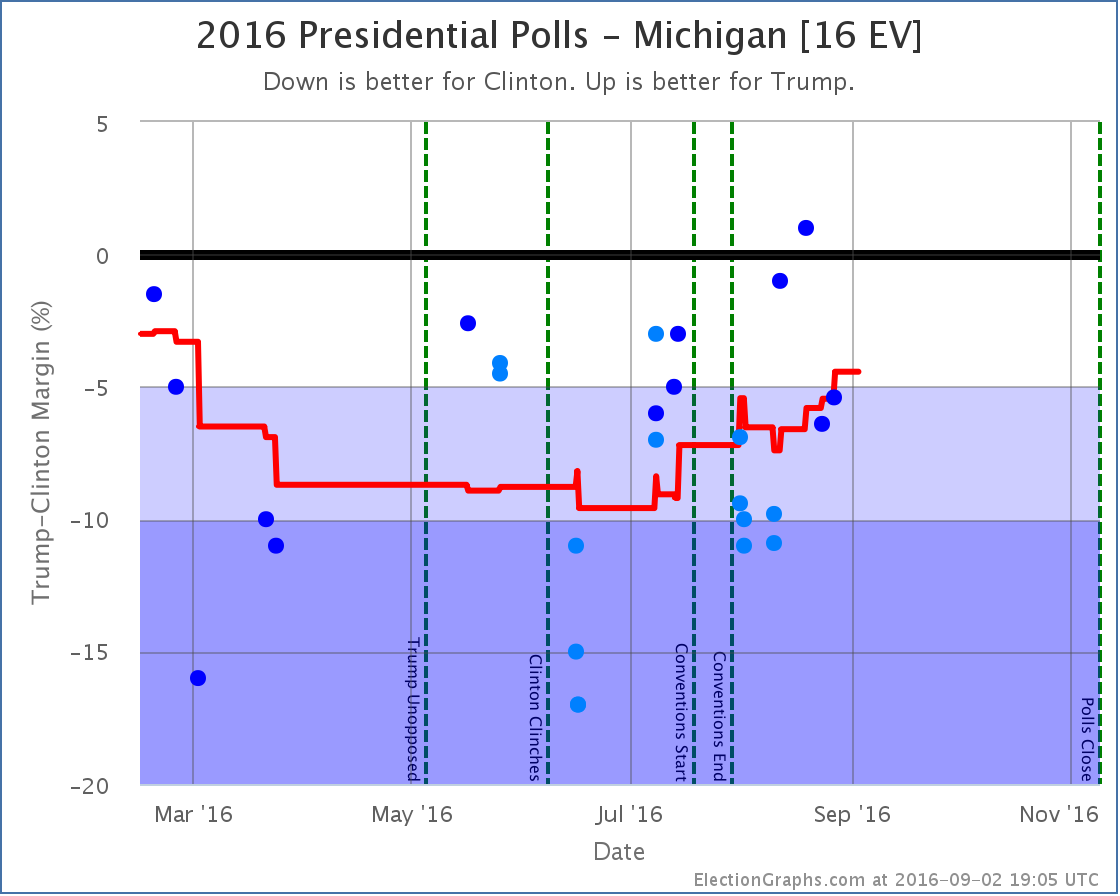
Despite a few bad polls for Trump right after the convention, the general trend in Michigan has been a tightening race since the beginning of July. With the latest, Clinton’s lead falls to only 4.4%. For the first time since March, Michigan is looking possible for Trump, so we now include it in his best case.
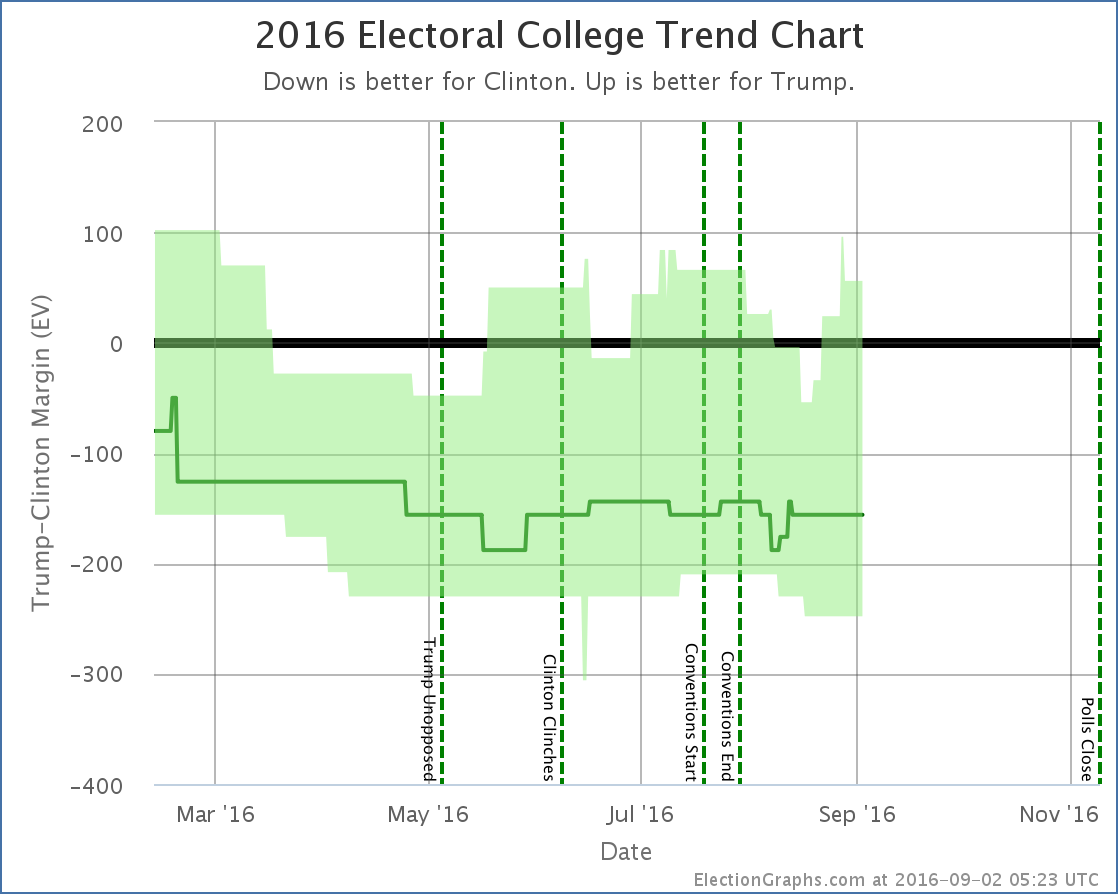
If Trump wins all the states he is ahead in, plus all the states where Clinton leads by less than 5%, he now wins by 56 electoral votes.
(Note the transient spike on the chart as well. This was caused by one poll added in this batch briefly bringing Pennsylvania back into reach for Trump, but another poll added in this same batch increased Clinton’s lead again right away, so there was no net change due to Pennsylvania this time.)
Tipping Point
Ohio and New Hampshire were and still are “Weak Clinton” states, but they wiggled around a bit with the latest polls and moved the tipping point from Clinton by 4.4% in Ohio to Clinton by 3.8% in Ohio, an 0.6% move toward Trump.
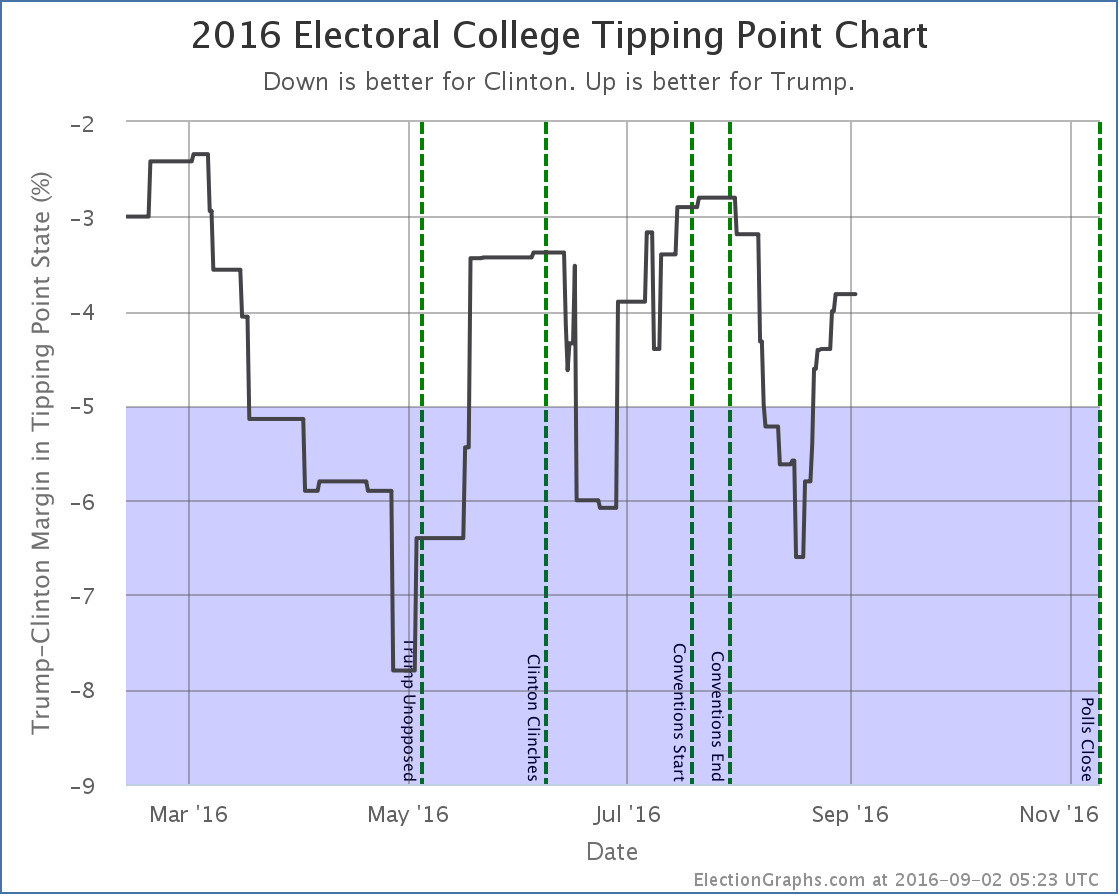
Overall
In both the Trump best case and the tipping point, we see Trump clearly reaching a peak during the conventions, then plummeting the first half of August, then recovering ever since. He isn’t quite back to where he was before the conventions, but he is getting close.
So far Trump is making a lot of states that were not close a few weeks ago close. But no states have crossed the center line in the last couple of weeks. We have seen this before. There are a variety of blue states where Trump seems to be able to come close, but he is having a hard time pulling them across the line into the red zone.
Since the conventions the “expected” case has been in the range between Clinton winning by 144 and Clinton winning by 188. Trump hasn’t done better than losing by 144 electoral votes since before he was locked up the Republican nomination. The test for any continued Trump rebound will be if he can start to move not just his best case, but the expected case as well. Can he actually flip states? Or just make them close?
The electoral college margin in the expected case is deceptive, because these numbers can change very quickly. The tipping point is the thing to watch at the moment. At a 3.8% Clinton margin, less than 1 out of 50 people have to change their minds to flip the outcome. The public is polarized, but 1 out of 50 isn’t all that much in the grand scheme of things. You can imagine events that would flip that many people if Clinton has a bad week.
Historically though, Trump is very near his previous ceilings. Every other time he has reached these levels, he has fallen back down fairly quickly. Will this time be different?
67.2 days until the polls start to close.
Note: This post is an update based on the data on ElectionGraphs.com. Election Graphs tracks both a poll based estimate of the Electoral College and a numbers based look at the Delegate Races. All of the charts and graphs seen in this post are from that site. Additional graphs, charts and raw data can be found there. Follow @ElectionGraphs on Twitter or like Election Graphs on Facebook to see announcements of updates or to join the conversation. For those interested in individual general election poll updates, follow @ElecCollPolls on Twitter for all the polls as they are added. If you find the information in these posts interesting or useful, please consider visiting the tip jar.
States with new poll data added since the last update: None, this isn’t that kind of update. Instead of new data, there is a change to how averages are calculated.
TL;DR
I changed the details on the way the poll averages are calculated to prevent pollsters who release multiple results on the same poll from having an outsized influence on the average. This changed the overall national summary as follows:
- Trump’s best case improved from winning by 4 electoral votes to winning by 24 electoral votes, since Wisconsin now looks like a close state that Trump has a shot in.
- The tipping point moved from Clinton by 4.0% in NH to Clinton by 4.4% in OH as the average moved a little toward Clinton in Ohio.
- Clinton’s best case improved from winning by 226 electoral votes to winning by 248 electoral votes since Arizona once again looks like a close state that Clinton has a shot in.
The changes also modified the shape of the historical graphs a bit. Details follow for those who are interested.
The Problem
The issue is that sometimes pollsters release multiple results from a single underlying poll sample. For instance they will give results when only the two major party candidates are mentioned, but also results if respondents are also asked about third party candidates. Or they will release both “registered voter” and “likely voter” results. Or other variants.
In the interest of simplicity and a bias toward including as much data as possible, when this happened, I included all of the different results a pollster released, and just threw them into the average as if they were completely independent results.
But of course they are not.
Since the same underlying sample was used, the results are often much more similar to each other than separate polls tend to be. So I was essentially giving extra weight to pollsters who tended to release multiple results. This has the effect of making the averages more volatile than they would be otherwise, since effectively I’d be really using fewer data sources to determine the average rather than the normal minimum of five.
In some cases pollsters were even starting to release four separate results, which since I generally use five poll averages could mean that four of the five polls in the average came from the same sample. In other cases almost every poll in a state included multiple results. It was clear this was having an impact and I would probably have to change something.
The Solution
I considered a number of possible ways to address this over the last couple months. Over the last few weeks I have also been engaging with a number of Election Graphs readers about this issue and the possible solutions via the comments on this site, email, and even by phone in one case. You can see some of this discussion in the post here.
In the end I selected a solution where I weight these types of results so that if a poll includes two different variants, each of those results count as half a poll, both for the averaging itself and for determining which polls to include in the average. If the poll released three variants, each would count as a third of a poll, if they release four, each would count as a fourth, etc.
Using Iowa as an example:
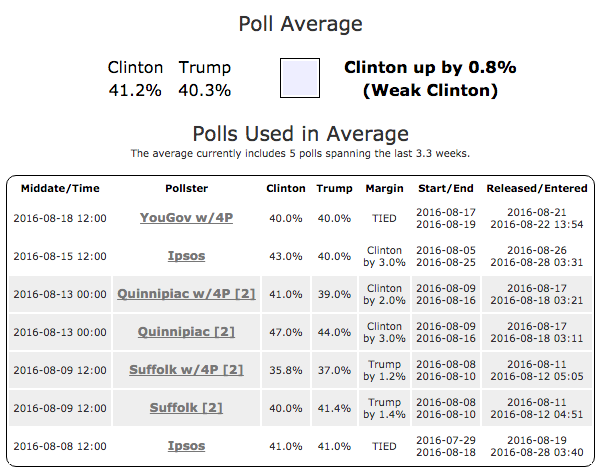
Quinnipiac and Suffolk released two results each, one with just the two major candidates, one with Johnson and Stein also added into the question. The polls in question get a grey background to highlight that they are being weighted. The more variants a poll has, the darker the grey. The number in [] indicates how many variants were in that poll. The summary still says this is an average of five polls, as each of the Quinnipiac and Suffolk variants count as half a poll in the averaging.
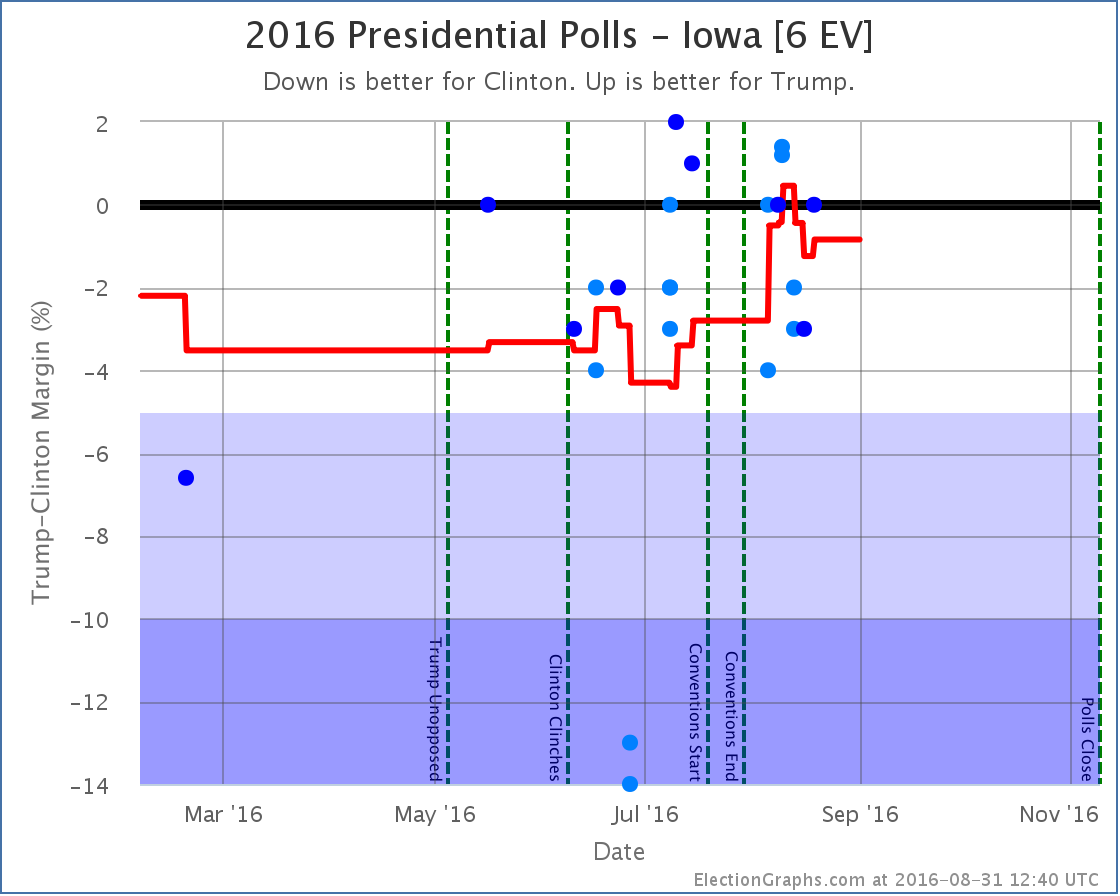
The graphs also change the color of data points that are weighted in this way. The lighter the color of blue, the less weight to the data point. This makes it as clear as possible when viewing these charts that some of the data points count more than others.
The Impact
Obviously any change to the way in which averages are constructed will cause those averages to be different. There are any number of choices made on this site that would have similar impact. As an example, the choice of five poll averages rather than using six polls or four polls. The general picture wouldn’t be expected to change much, but some details will.
In this case there were three states that changed in ways that caused an adjustment to the national summary. For each of these I’ll show an animation of the state chart before and after the change. The frame of the animation that includes lighter blue dots is the new version of the chart.
Ohio [18 EV]
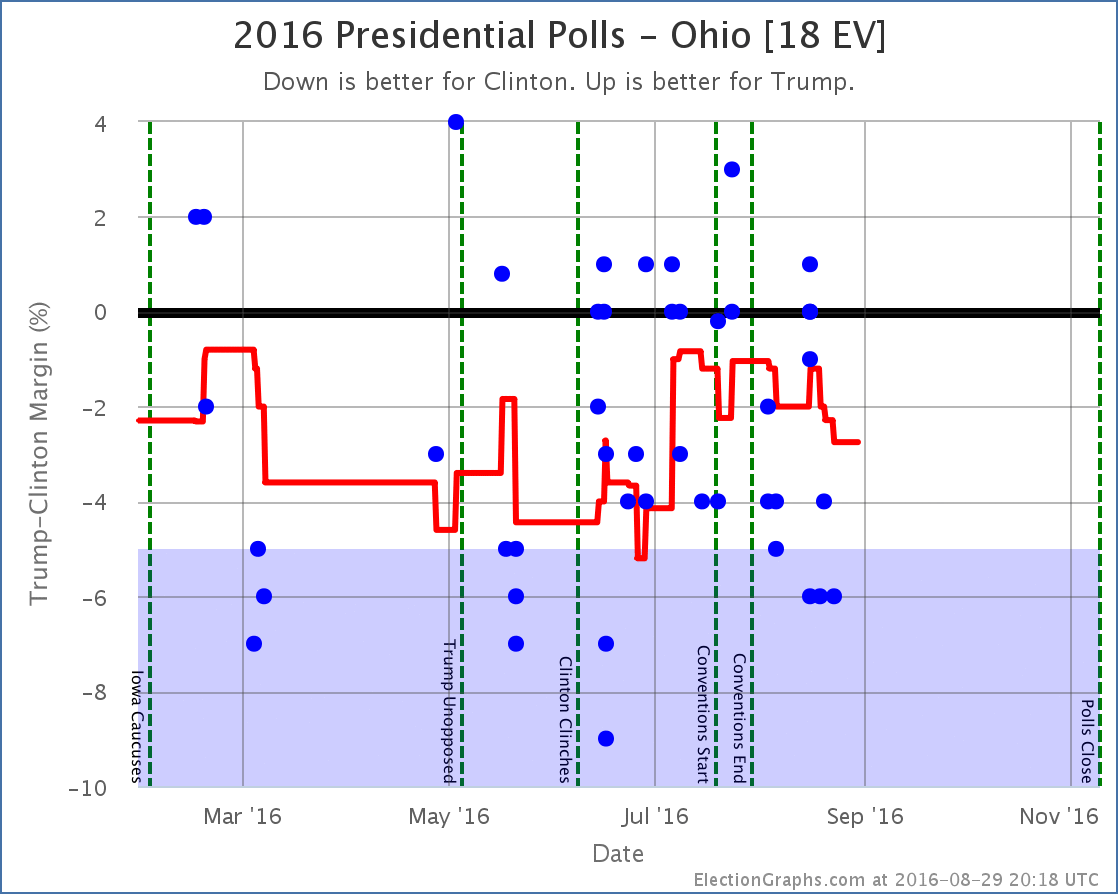
Ohio moved from a 2.8% Clinton lead to a 4.4% Clinton lead, a 1.6% move toward Clinton. Ohio is classified as “Weak Clinton” either way, but this changed the tipping point. This also eliminated a brief period earlier in the year when Ohio had been “Strong Clinton”.
Arizona [11 EV]
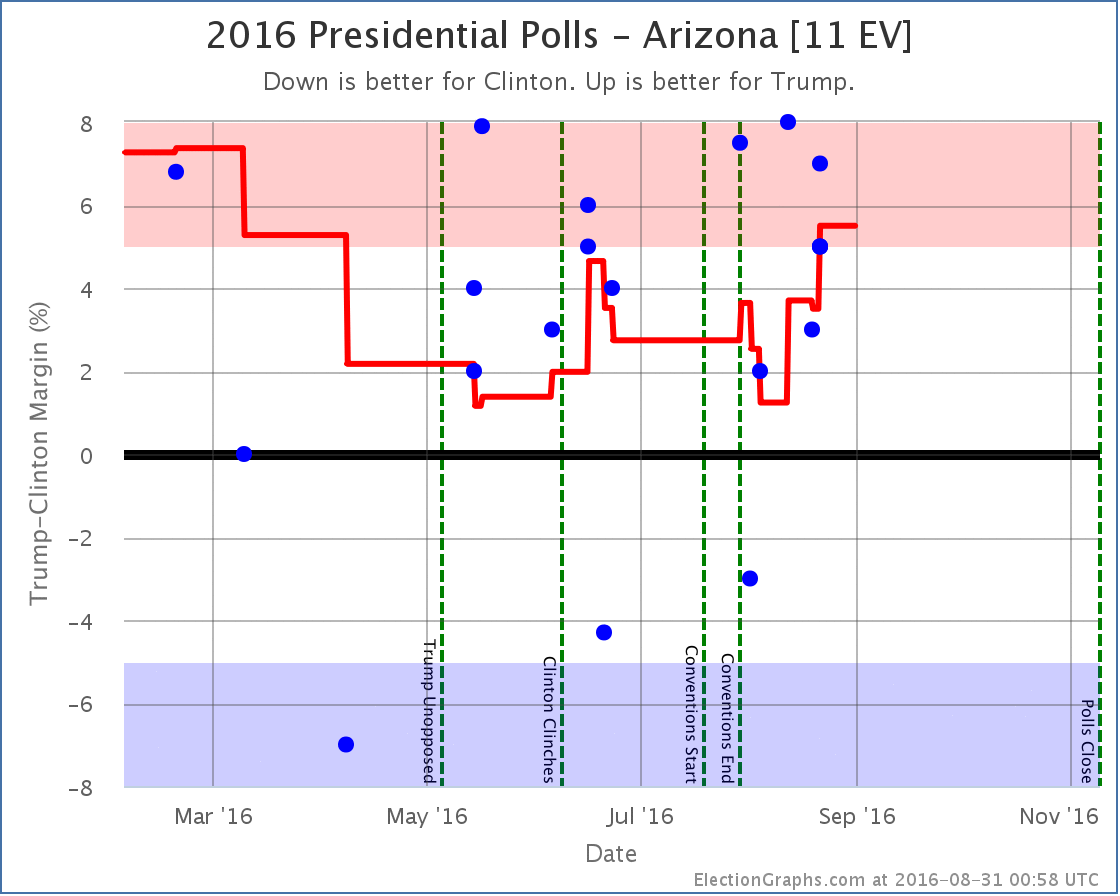
Arizona moved from a 5.5% Trump lead to a 3.1% Trump lead, a 2.4% move toward Clinton. This undid the recent Arizona move from “Weak Trump” to “Strong Trump” and improved Clinton’s best case from winning by 226 electoral votes to winning by 248 electoral votes since Arizona now once again looks like a close state that Clinton has a shot in.
Wisconsin [10 EV]
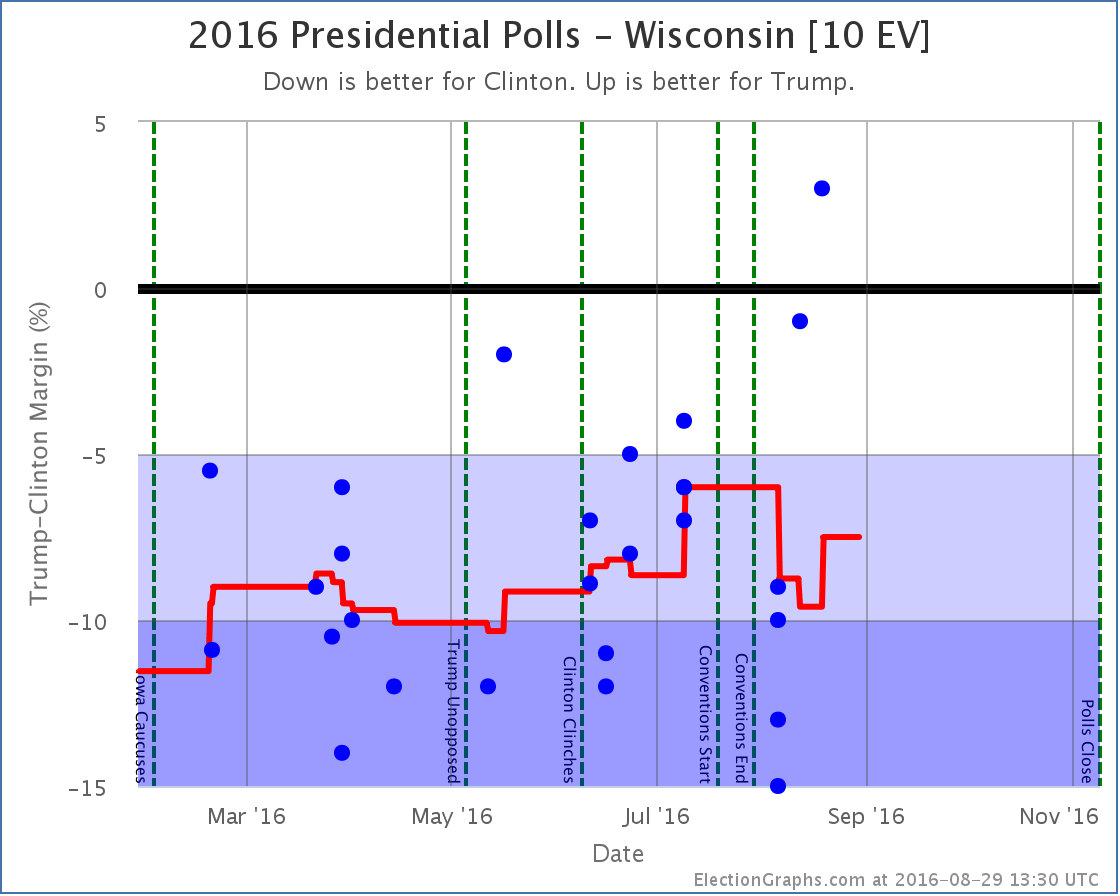
Wisconsin moves from a 7.5% Clinton lead to a 4.8% Clinton lead, a 2.7% move toward Trump. This moves Wisconsin from “Strong Clinton” to “Weak Clinton”, putting the state in play for Trump and improving his best case from winning by 4 electoral votes to winning by 24 electoral votes.
Other states
A number of other states were impacted by the change in how averages are constructed, but did not do so in ways that in turn changed the national summary. These were:
- California [55 EV]: Clinton 28.6% -> Clinton 28.3% (0.3% toward Trump)
- Texas [38 EV]: Trump 10.0% -> Trump 10.3% (0.3% toward Trump)
- Florida [29 EV]: Clinton 1.3% -> Clinton 2.0% (0.7% toward Clinton)
- New York [29 EV]: Clinton 21.7% -> Clinton 19.8% (1.9% toward Trump)
- Pennsylvania [20 EV]: Clinton 7.3% -> Clinton 7.1% (0.2% toward Trump)
- Georgia [16 EV]: Trump 0.8% -> Trump 0.8% (Historical graph change only)
- Michigan [16 EV]: Clinton 5.4% -> Clinton 5.5% (0.1% toward Clinton)
- North Carolina [15 EV]: Clinton 1.2% -> Clinton 1.8% (0.6% toward Clinton)
- New Jersey [14 EV]: Clinton 15.0% -> Clinton 12.7% (2.3% toward Trump)
- Virginia [13 EV]: Clinton 10.6% -> Clinton 11.2% (0.6% toward Clinton)
- Washington [12 EV]: Clinton 16.0% -> Clinton 14.4% (1.6% toward Trump)
- Massachusetts [11 EV]: Clinton 17.7% -> Clinton 18.8% (1.1% toward Clinton)
- Colorado [9 EV]: Clinton 8.3% -> Clinton 8.4% (0.1% toward Clinton)
- South Carolina [9 EV]: Trump 2.0% -> Trump 3.2% (1.2% toward Trump)
- Connecticut [7 EV]: Clinton 7.6% -> Clinton 7.4% (0.2% toward Trump)
- Iowa [6 EV]: Clinton 0.9% -> Clinton 0.8% (0.1% toward Trump)
- Mississippi [6 EV]: Trump 15.2% -> Trump 13.0% (2.2% toward Clinton)
- Nevada [6 EV]: Clinton 1.8% -> Clinton 1.8% (Historical graph change only)
- Utah [6 EV: Trump 12.6% -> Trump 10.9% (1.7% toward Clinton)
- New Hampshire [4 EV]: Clinton 4.0% -> Clinton +4.0% (Historical graph change only)
- Alaska [3 EV]: Trump 10.8% -> Trump 12.3% (1.5% toward Trump)
- Maine-All [2 EV]: Clinton 4.4% -> Clinton 2.0% (2.4% toward Trump)
If anybody is interested in the before/after animations for any of these states, ask me. It would have been too much to include them all here in this post.
National View
The changes in all these states of course changed the two national graphs as well. The versions with data a little further to the right are the “after” frames.
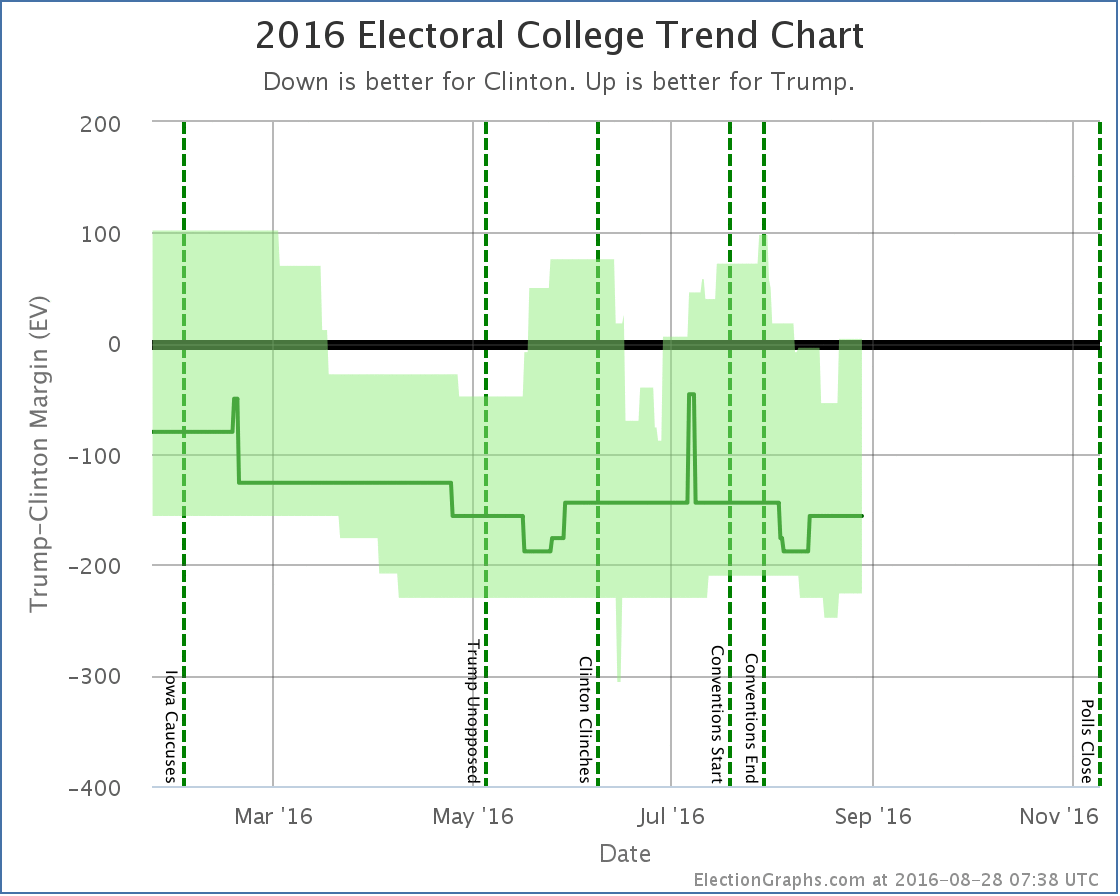
The overall shape of the electoral college trend chart is similar before and after, although Trump’s best case is now a bit better off in the time between Clinton clinching and the start of the conventions. The brief July spike toward Trump in the expected case also disappears. And of course both candidate’s best cases improve a bit at the current time.
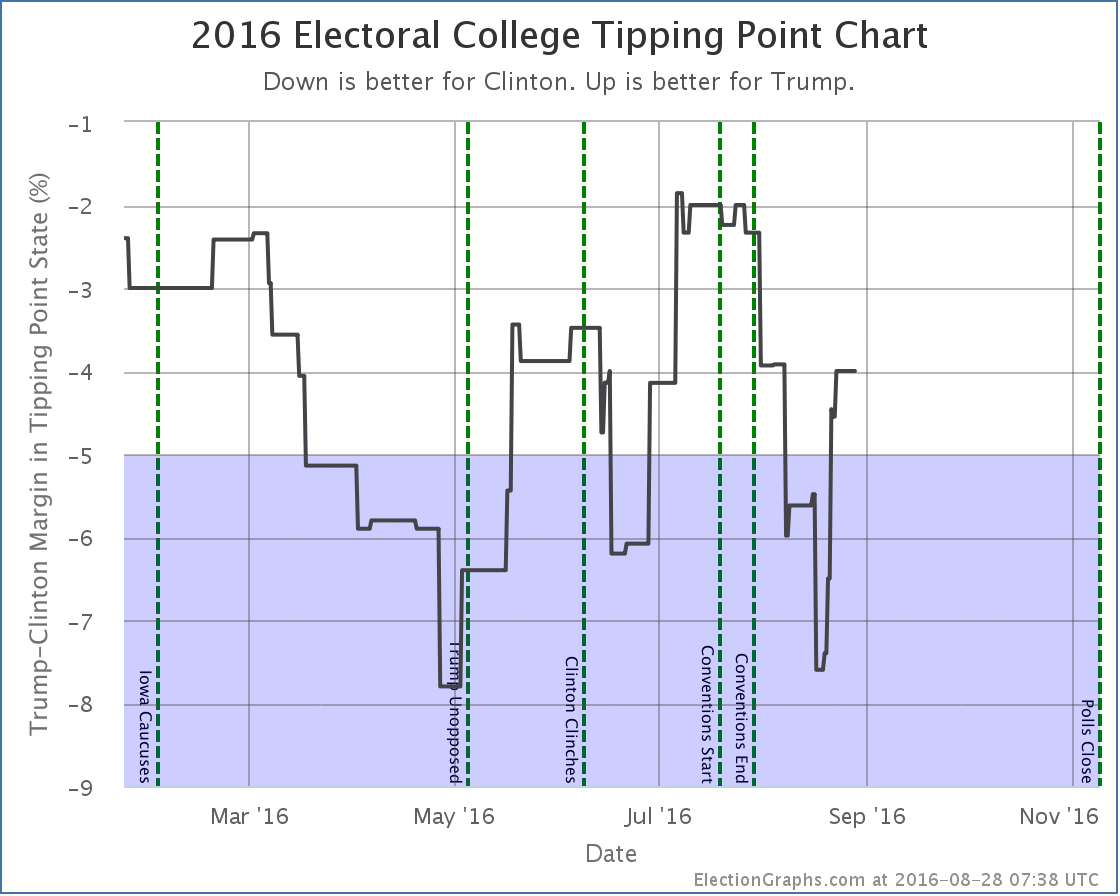
The main impact on the tipping point chart seems to have been to mute the extremes. The high in July wasn’t quite as high, the low in August wasn’t quite as low.
The map view would have changed too of course, but unfortunately I did not save off a “before” version of the map, so couldn’t produce a nice animation. The graphs above tell the story nicely though I think.
In the end, while I think this correction was important to make, it doesn’t significantly change much in the national view, or the narrative of this campaign. Trump has been behind the entire race. At times he has been able to make it a bit closer, but then seems to fall back again. Electoral college wise Clinton seems to be bouncing between winning by 144 electoral votes and winning by 188 electoral votes in the “expected case”. The range between the best cases is wider and a bit more volatile, and usually includes a narrow Trump win as a possibility, but often does not. On the tipping point, Trump’s ceiling seems to be about a 2.5% Clinton lead, and his floor seems to be about an 8% Clinton lead.
All in all, with these bookkeeping changes in place to stop giving extra weight to some pollsters, the race looks even more stable than it did before. Yes, things bounce around a bit, but fundamentally we’re in basically the same place we have been since mid-May with only minor changes.
We can and will continue to talk about the ups and downs day to day and week to week, but absent something really big happening, this race looks like it doesn’t want to budge much.
69.1 days for that to change.
Note: This post is an update based on the data on ElectionGraphs.com. Election Graphs tracks both a poll based estimate of the Electoral College and a numbers based look at the Delegate Races. All of the charts and graphs seen in this post are from that site. Additional graphs, charts and raw data can be found there. Follow @ElectionGraphs on Twitter or like Election Graphs on Facebook to see announcements of updates or to join the conversation. For those interested in individual general election poll updates, follow @ElecCollPolls on Twitter for all the polls as they are added. If you find the information in these posts interesting or useful, please consider visiting the tip jar.
States with new poll data since the last update: Florida, Illinois, Pennsylvania, New Hampshire, Ohio, North Carolina, Nevada, New York, Texas, California, New Jersey, Minnesota, Georgia, North Carolina, Indiana, Arizona, Missouri, Massachusetts, Virginia, Tennessee, Washington, Michigan, Wisconsin, Mississippi, Oklahoma, Idaho, Maryland, Oregon, Maine (All), Louisiana, Colorado, Iowa, Nebraska (All), South Carolina, Alabama, West Virginia, Kansas, Kentucky, Utah, Arkansas, Connecticut, Delaware, New Mexico, Montana, Alaska
Wow, that is a lot of new polls. While there were some others, the big influence today is that Reuters/Ipsos has started to do a weekly nationwide tracking poll where they provide state breakdowns for any state where they have enough data. So from now until the election we should start getting regular data on a lot of states that usually don’t get polled.
As usual, most of the updates didn’t change the status of the model, but a few did, and all of these moves this time were toward Trump. Lets take a look state by state:
Arizona [11 EV]
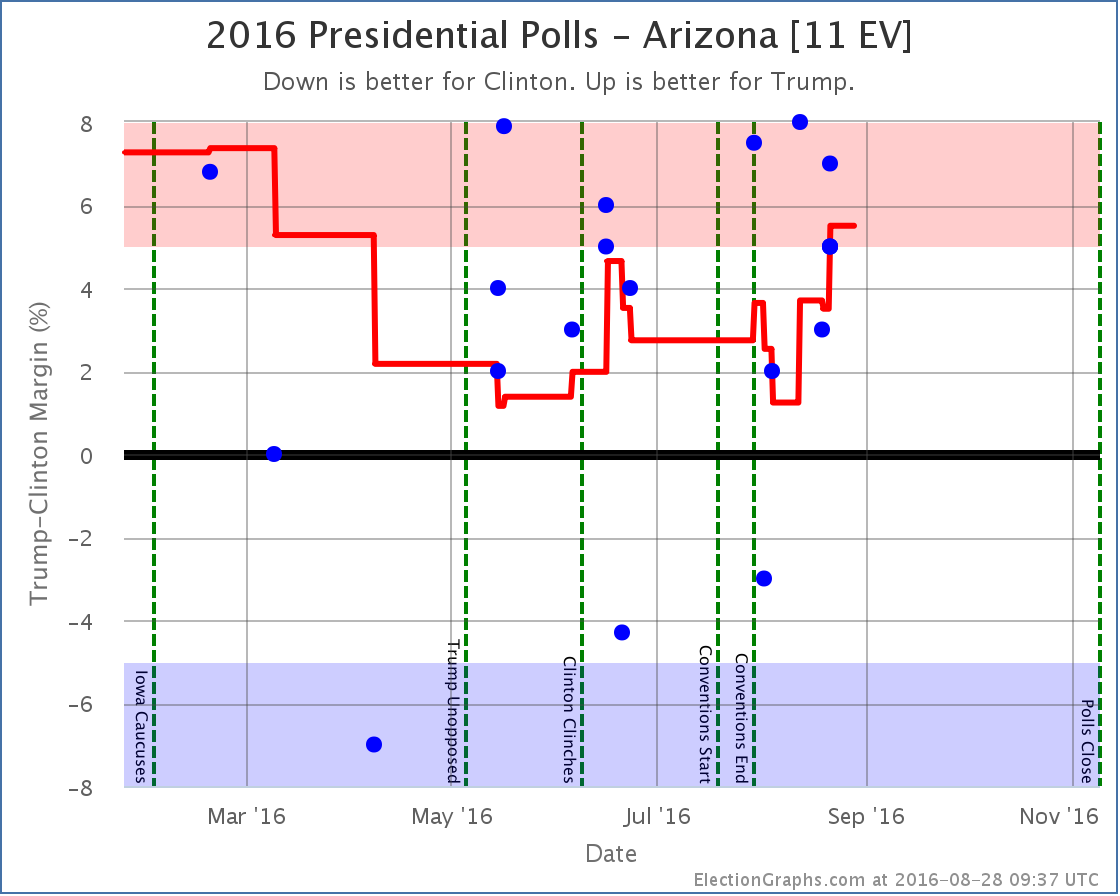
Ever since April Arizona has been looking like a possible target for Clinton… Trump ahead, but with only a narrow lead that Clinton might be able to flip. With the latest updates, Trump’s lead in the average increases to 5.5%, so we take it out of that category. The notion of a blue Arizona slips away from Clinton.
New Hampshire [4 EV]
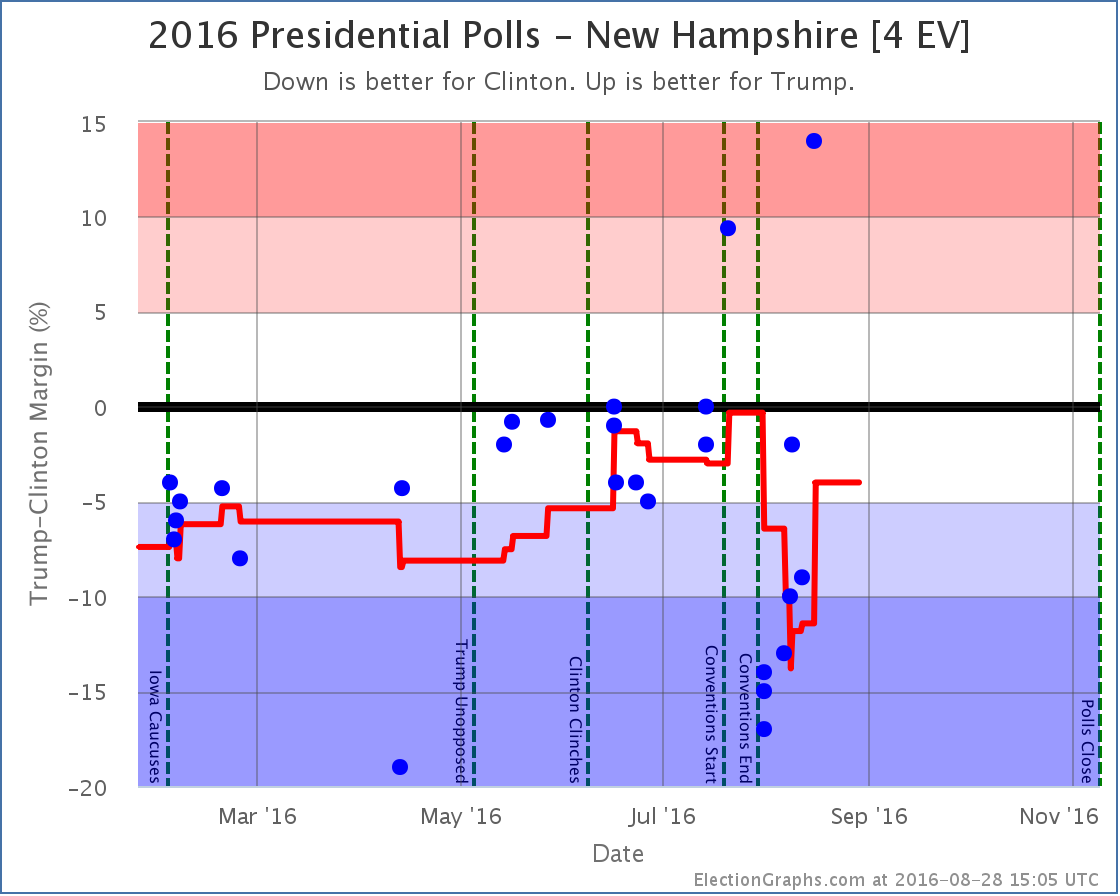
Honestly, it looks like an outlier, but the most recent of those Reuters/Ipsos results I mentioned show Trump with a huge 14% lead in New Hampshire. The second best number in the average shows Clinton up by 2%, and that is also from Ipsos. All the other recent numbers in New Hampshire show a Clinton lead of at least 9%, and there has been no radical change in the campaign that would indicate a huge swing would be expected.
If these two Ipsos data points are really outliers, then new polls should quickly show that. For the moment though, the average moves to only a 4.0% Clinton lead due to the two Ipsos data points, so New Hampshire is once again categorized as a state Trump has a chance in.
Maine (All) [2 EV]
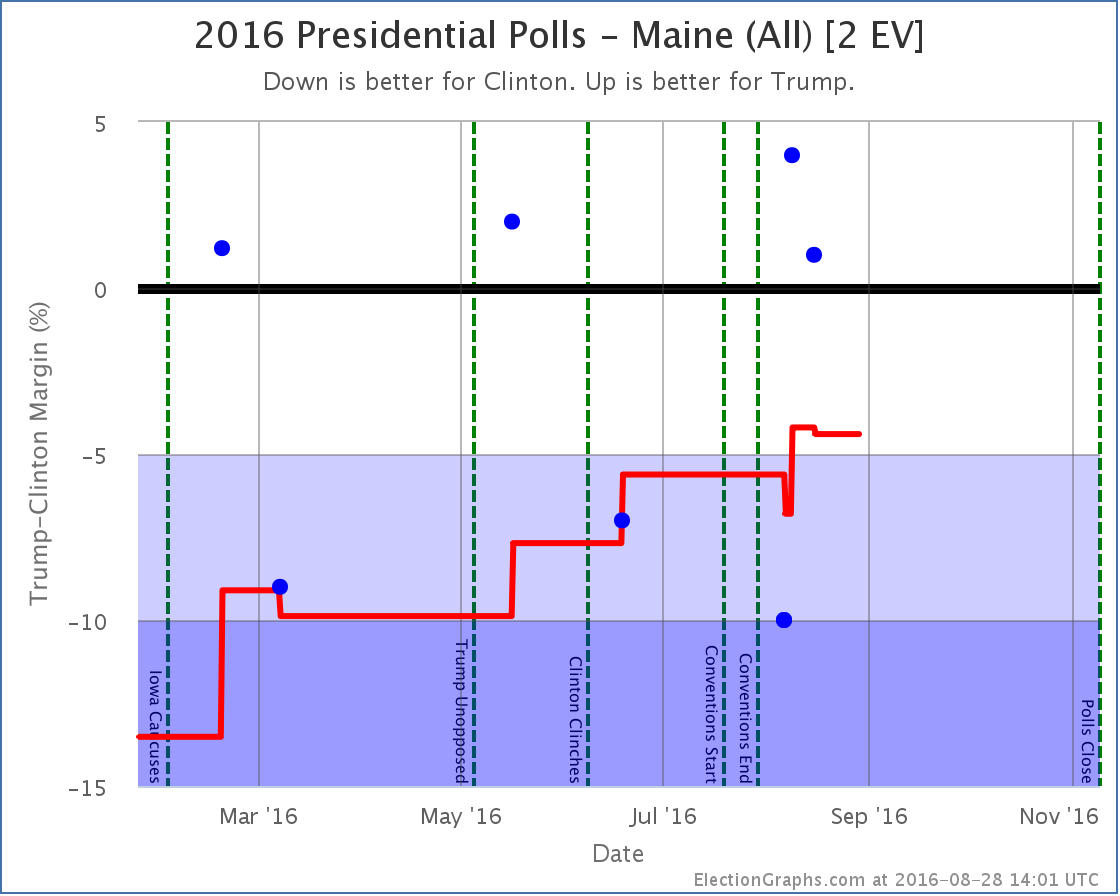
Maine has been pretty sparsely polled this Election cycle, but what polls we do have show the state trending away from being a solid blue state to being close. The latest couple of results (both Ipsos) have Trump ahead, as have a few previous polls. The average is now only a 4.4% Clinton lead, so Maine is now in the “Weak Clinton” category, and it is included in Trump’s best case.
Now, Maine is one of the two states that splits electoral votes. For winning Maine at large, you only get 2 electoral votes. You then get 1 electoral vote for winning each congressional district. Now, mathematically, for Maine as a whole to have a 4.4% lead for Clinton, Trump would have to be doing even better than that in one of the two congressional districts. But right now the average in CD-1 is a 15.8% Clinton lead and in CD-2 it is a 5.3% Clinton lead. That can’t be! You would expect CD-2 to be Weak Clinton as well, or possibly even Weak Trump.
The problem is that while there has been very limited polling of Maine as a whole, there has been even less polling of Maine at a Congressional District level. There has only been ONE poll of Maine CD-2 this election cycle. It was in June and showed Trump up by 1%. The average is 5.3% Clinton because in order to fill out the average when there are less than five polls, I use previous election results.
New polling in Maine CD-2 is currently what I classify as the “Most Needed Poll” (followed be NE-2, NE-1, ME-1 and SD). Right now we don’t have enough polling evidence to show that CD-2 is actually Weak Clinton or Weak Trump rather than Strong Clinton, but given where Maine as a whole is, the ME-2 electoral vote has to be a possible pick up for Trump too, but it won’t be categorized that way here until there are enough polls backing that up directly.
National View
Before showing the new national trend chart and tipping point charts, a quick note. In addition to the new polls added in the most recent batch, I found a handful of older polls that I had somehow missed earlier in the year. These don’t change the current picture, but they change the past. Specifically, Trump’s position in the spring was significantly weaker than it looked at the time, mainly because Florida would have slipped out of his reach significantly earlier.
To be transparent on this change, rather than just show the new charts, I’ll show the before and after due to today’s update. First the trend chart as it appeared on Election Graphs as of the August 26th update post:
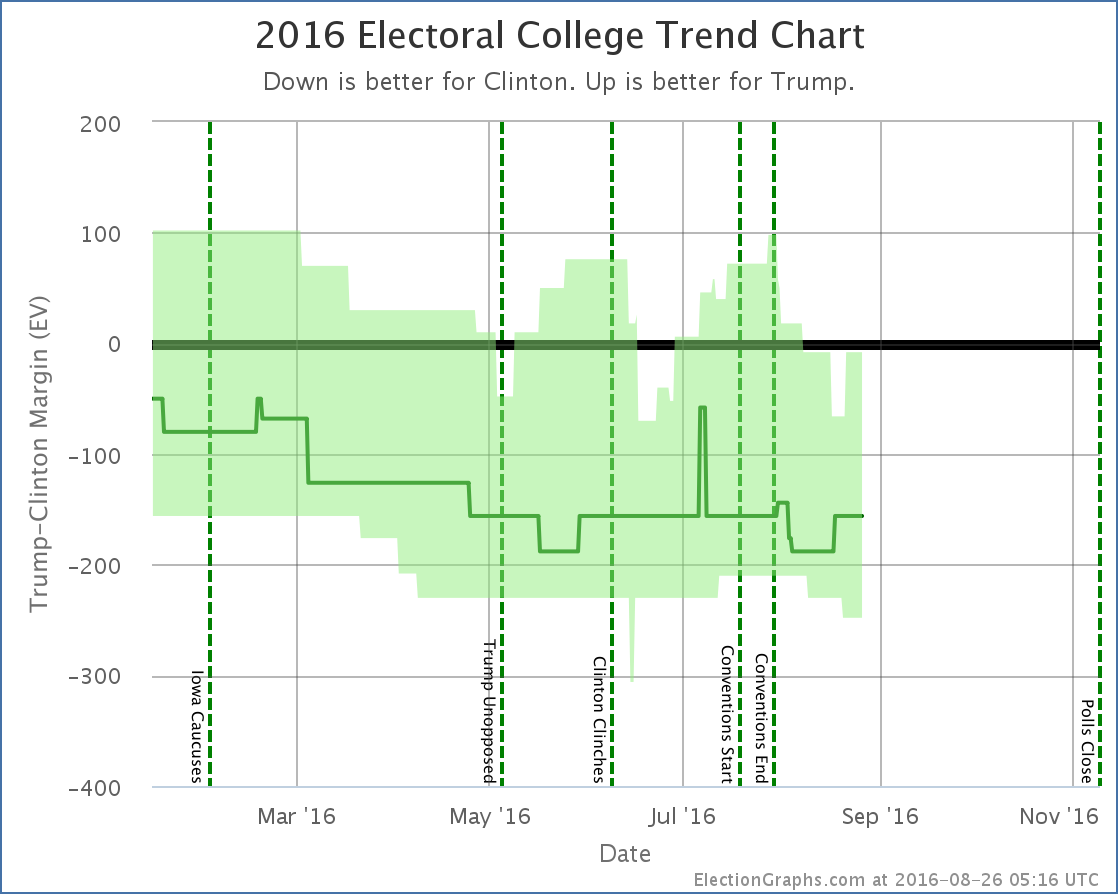
And here it is now:

Note that in addition to the bumps upward in Clinton and Trump’s current best cases, Trump’s best case in the spring is significantly depressed, enough so that his best case moved from a narrow win in most of April to a narrow loss. There are some other subtle differences between these two caused by the addition of these old polls I had missed at the time, but that is the big one, caused essentially by one March poll in Florida that I did not see until August. Apologies for that.
The difference in the tipping point graph is even more dramatic, with Florida worse for Trump than it previously looked, there was a lot more room for the tipping point to wiggle, and it was a lot worse during the spring than it looked.
Here is the before picture of the tipping point graph from the August 26th update post:
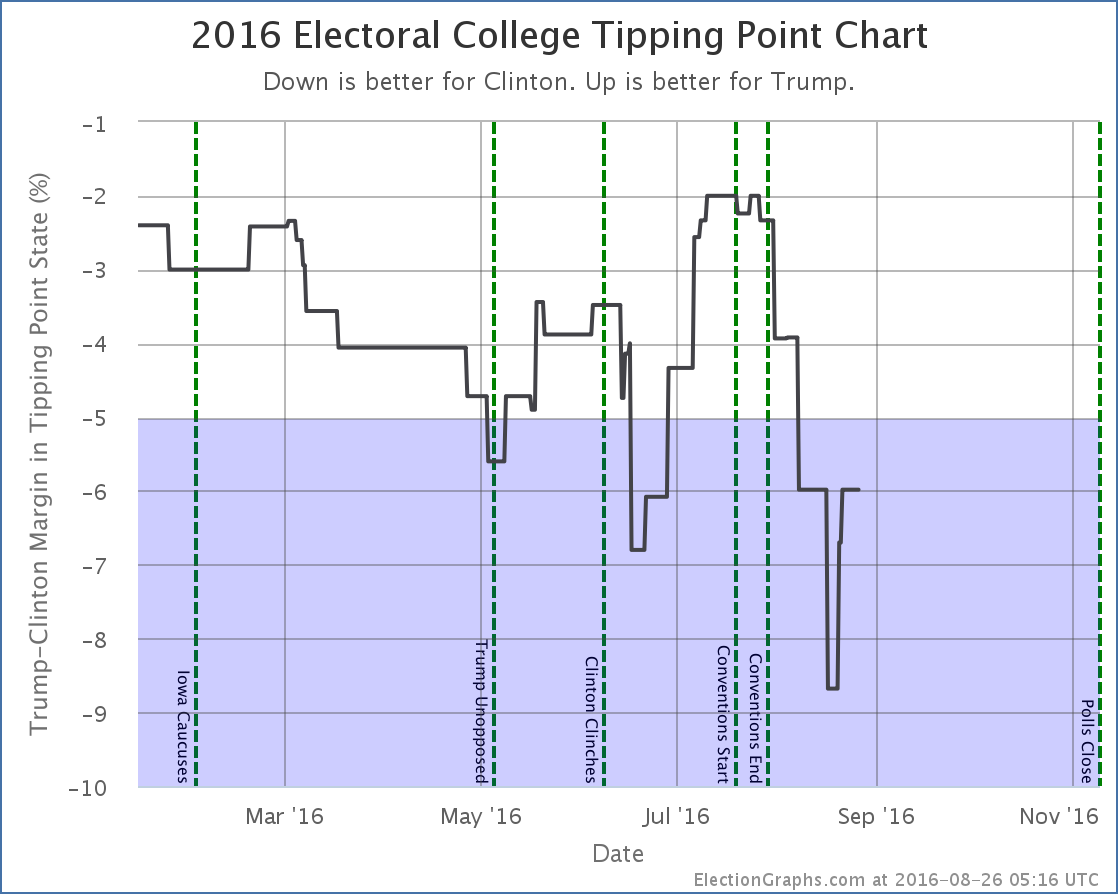
And here is the tipping point graph now:

Again the main impact is that the “missing polls” that I added make it clear that Trump was significantly worse off in the spring than I had shown at the time. In fact, it means that at the end of April he was actually below his recent bottom in mid-August.
There were only a handful of polls missed, but this goes to show that even with poll averaging, individual polls in critical states can make a big difference in the overall picture. (Especially when they appear to be outliers, such as the one Florida poll I missed that made the biggest difference. Oops.)
OK, enough hand wringing about things that may have been missed in the spring.
The big current news on the tipping point is that with changes in the averages in Michigan, New Hampshire, and Ohio, the tipping point comes roaring back in Trump’s direction. In this update it moves from a 6.0% Clinton lead in Connecticut to a 4.0% Clinton lead in New Hampshire, but this is a full 3.6% swing toward Trump since his low of 7.6% about 10 days ago.
Now, everything above still shows a Trump loss, but it is looking a lot closer than it did a couple weeks ago. The first part of August was disastrous for Trump, but he has been bouncing back since then. He is still very far behind, but maybe his latest reworking of his campaign is working. His best case is once again to win, although by a very narrow 4 electoral vote margin.
Will the recent trend continue and make this race look even closer? 72.2 days left for him to do it.
Notice on Methodology: In my August 13th update I solicited opinions on possibly changing how this site deals with the case when a pollster releases multiple results from a single poll. See the discussion in that comment thread for more details. Immediately after this post goes live I will be working to change the site logic so that if two results are released from a poll, each counts as only half a poll for purposes of the averages here. Similar logic will apply to tracking polls where samples overlap, but not completely, with polls weighted to reflect the fraction of the new result that is actually from a fresh sample.
As examples of the impact this could have, the three states mentioned in this post would change as follows: Arizona is a 5.5% Trump lead (Strong Trump) with the current logic, it would be a 3.9% Trump lead (Weak Trump) with the new logic. New Hampshire would move from a 4.0% Clinton lead (Weak Clinton) to a 8.4% Clinton lead (Strong Clinton). Maine (All) would move from a 4.4% Clinton lead (Weak Clinton) to a 3.7% Clinton lead (Weak Clinton). With these three examples, two of the changes favor Clinton, and one favors Trump.
At this point I will not be adding new polls to the averages until the math changes are complete and I have reported on the results with a blog post. (Unless my revisions fail and I’m forced to reschedule for another weekend.)
[Note added 21:39 UTC – Actually, as I’m starting in, I realize that tracking polls have a bunch of extra complications that multiple results in a single poll don’t have, so I’ll leave them alone and treat them as if they were completely independent for now. Without weighting tracking polls, the changes above would now be: AZ Trump +5.5% -> Trump +3.1%, NH Clinton +4.0% -> Clinton +4.0% (No change), ME-All Clinton +4.4% -> Clinton +2.0%.]
Note: This post is an update based on the data on ElectionGraphs.com. Election Graphs tracks both a poll based estimate of the Electoral College and a numbers based look at the Delegate Races. All of the charts and graphs seen in this post are from that site. Additional graphs, charts and raw data can be found there. Follow @ElectionGraphs on Twitter or like Election Graphs on Facebook to see announcements of updates or to join the conversation. For those interested in individual general election poll updates, follow @ElecCollPolls on Twitter for all the polls as they are added. If you find the information in these posts interesting or useful, please consider visiting the tip jar.
States with new poll data since the last update: Florida, Michigan, Arizona, North Carolina
In the last update, Clinton’s lead in Florida moved to more than 5% and therefore winning Florida was taken out of Trump’s best case. At the time, I said: “Now, a couple of the data points here look like they might end up being outliers. If so, expect the average to bounce back a bit in Trump’s direction as new polls come out.” That has indeed already happened…
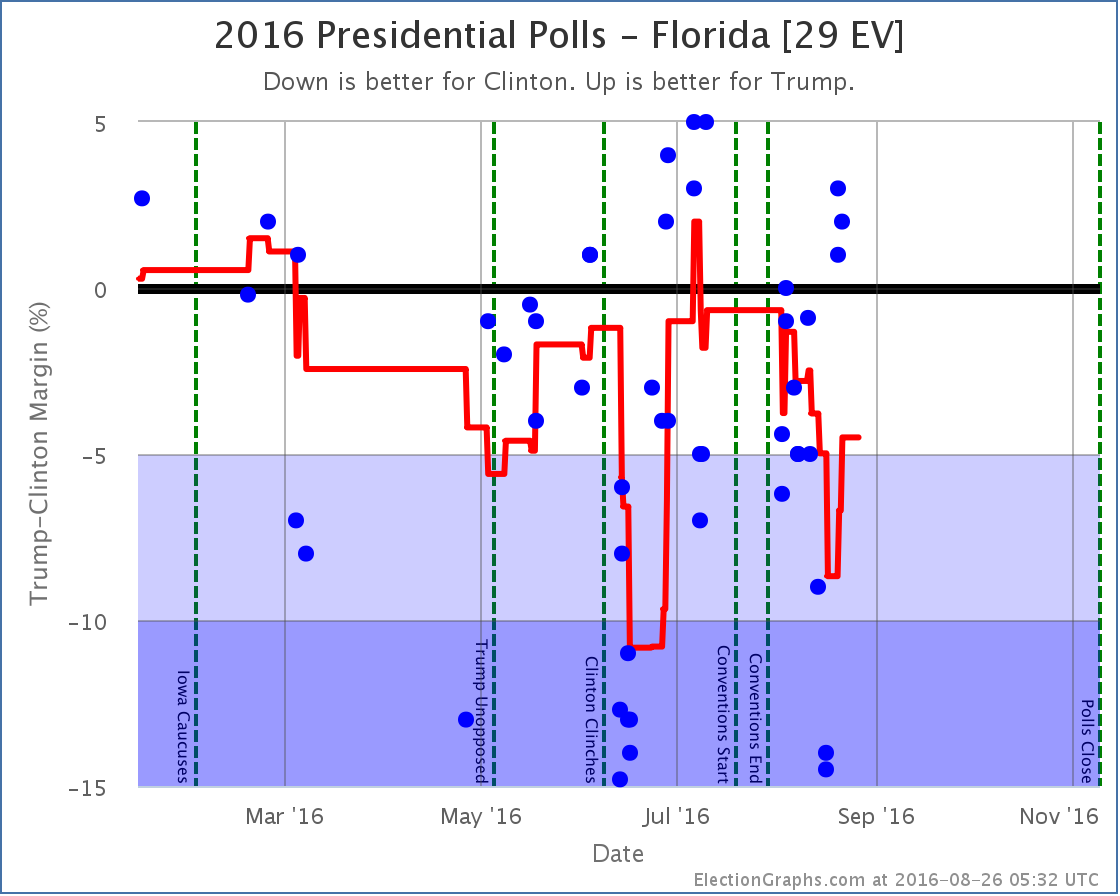
After several polls showing Clinton with a very strong lead, the last few results have shown Trump with a narrow lead. So the average bounces back toward Trump. On balance, Clinton still leads, but now only by 4.5%. Since this is under 5% Florida once again looks like a possible Trump pick up and is included in Trump’s best case:

Trump’s best case is still too lose, but with Florida in the mix it is a lot closer. If Trump wins all the states he is ahead in, plus all the states where he is close, he now loses by only 8 electoral votes.
Since Florida was the tipping point, that metric also moves:

The tipping point is now back at a 6.0% Clinton lead in Connecticut, back where it was a couple weeks ago.
So does this mean Trump is bouncing back? We have had a couple of moves toward Trump in the last couple weeks… but we have had even more moves toward Clinton. It is too early to call a bottom for Trump and say he is on his way back. As usual, we need to keep watching.
74.4 days left until polls start to close.
Notice on Methodology: In my August 13th update I solicited opinions on possibly changing how this site deals with the case when a pollster releases multiple results from a single poll. See the discussion in that comment thread for more details. This weekend I will be working to change the site logic so that if two results are released from a poll, each counts as only half a poll for purposes of the averages here. As an example of the impact that would have: With the current method Florida shows a 4.5% Clinton lead. With the proposed new method Florida would show a 4.8% Clinton lead. Both would be “Weak Clinton”.
Note: This post is an update based on the data on ElectionGraphs.com. Election Graphs tracks both a poll based estimate of the Electoral College and a numbers based look at the Delegate Races. All of the charts and graphs seen in this post are from that site. Additional graphs, charts and raw data can be found there. Follow @ElectionGraphs on Twitter or like Election Graphs on Facebook to see announcements of updates or to join the conversation. For those interested in individual general election poll updates, follow @ElecCollPolls on Twitter for all the polls as they are added. If you find the information in these posts interesting or useful, please consider visiting the tip jar.
States with new poll data since the last update: Ohio, Iowa, South Carolina, North Carolina, Virginia, Utah, Missouri, Florida, New Mexico
More bad news for Trump, this time from Florida and South Carolina:
Florida
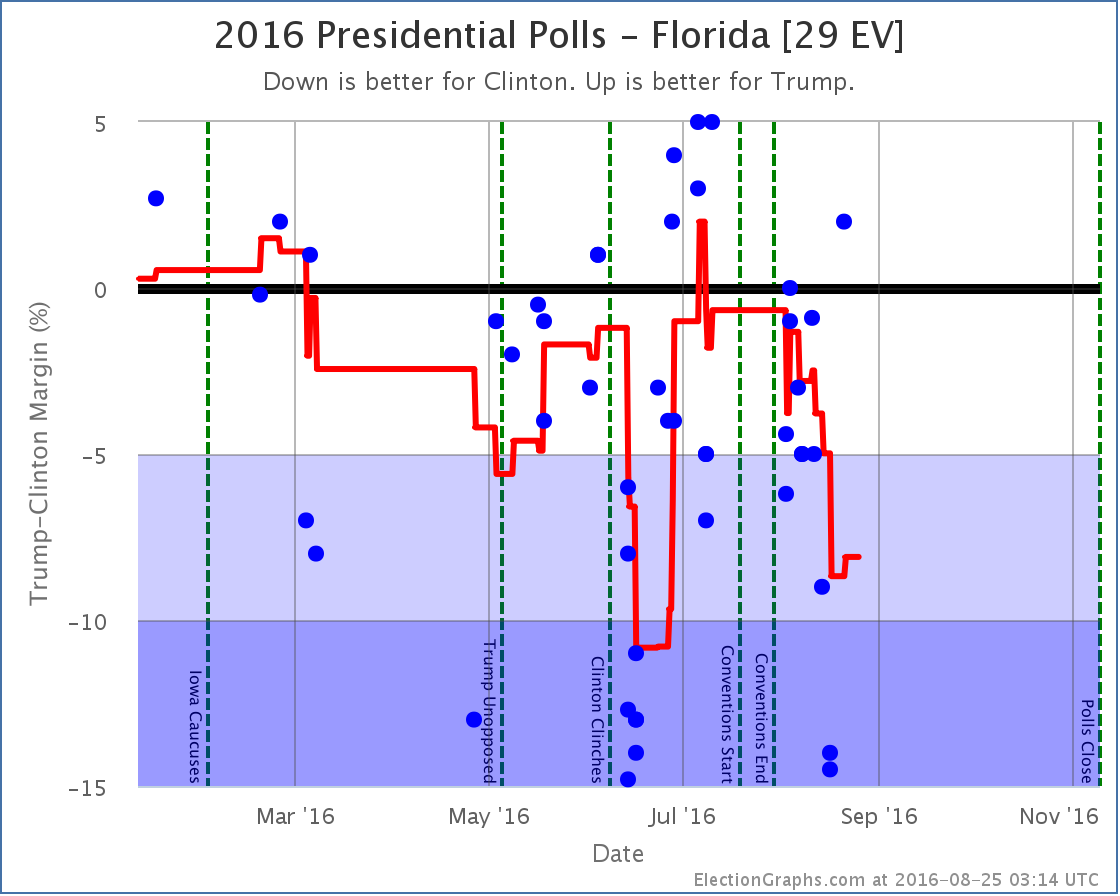
As has been somewhat the normal state of things in Florida, there is a huge range of poll results. At the moment the Election Graphs average includes results from Clinton leading by 14.5% to Trump leading by 2%. But on average, the polls have been trending toward Clinton, and with the latest additions, Clinton’s lead increases to 8.1%. Now, a couple of the data points here look like they might end up being outliers. If so, expect the average to bounce back a bit in Trump’s direction as new polls come out.
For the moment though, Clinton’s lead is big enough that Florida is no longer looking like a possible pickup for Trump. And Florida is part of almost any winning scenario for Trump. Without Florida a path to the White House is almost impossible.
South Carolina
Meanwhile, Trump is also slipping in South Carolina:
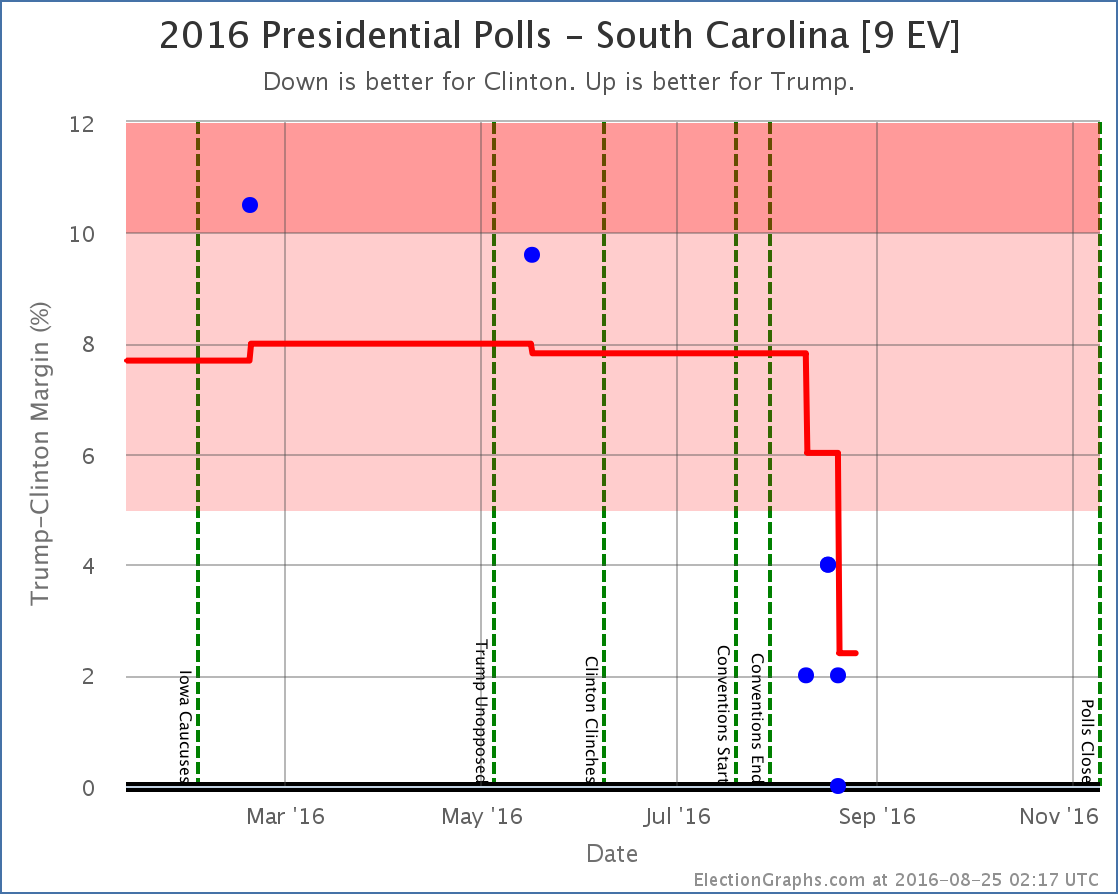
South Carolina hadn’t been polled much, but prior to the conventions the average there was a 7.8% Trump lead. Every poll since the conventions has shown Trump with a much narrower lead though. To be sure, there has not yet been any poll showing Clinton ahead in South Carolina. But the poll average drops to a 2.4% Trump lead. Narrow enough that Clinton stealing it has to be allowed as a possibility.
National View
With Florida no longer in play for Trump, and South Carolina now in play for Clinton, the “bubble” now looks like this:
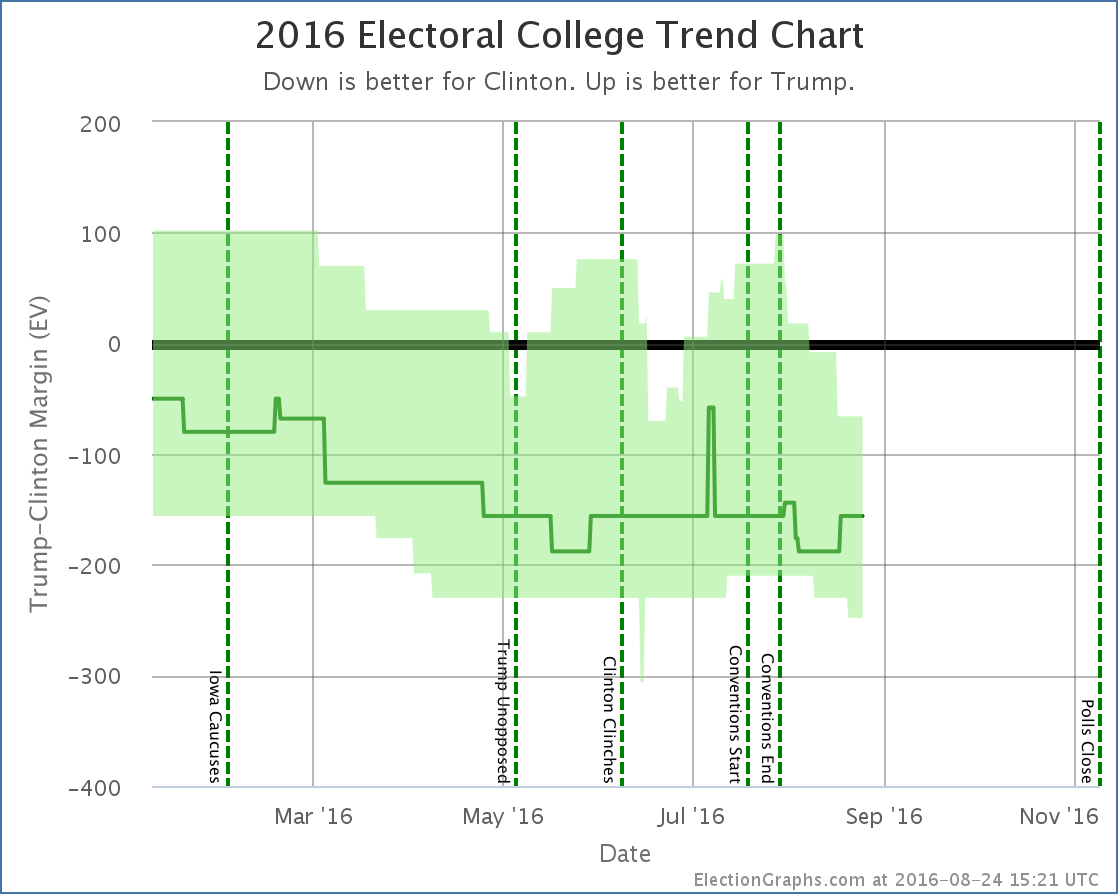
Trump’s best case is now almost as bad as it was back in June. Clinton’s best case is now the best it has been aside from those two days in June when Texas looked close.
The most dramatic change however has been in the tipping point. With Clinton’s lead in Florida increasing dramatically, the tipping point moved from a 6.0% Clinton lead in Connecticut to an 8.1% Clinton lead in Florida:
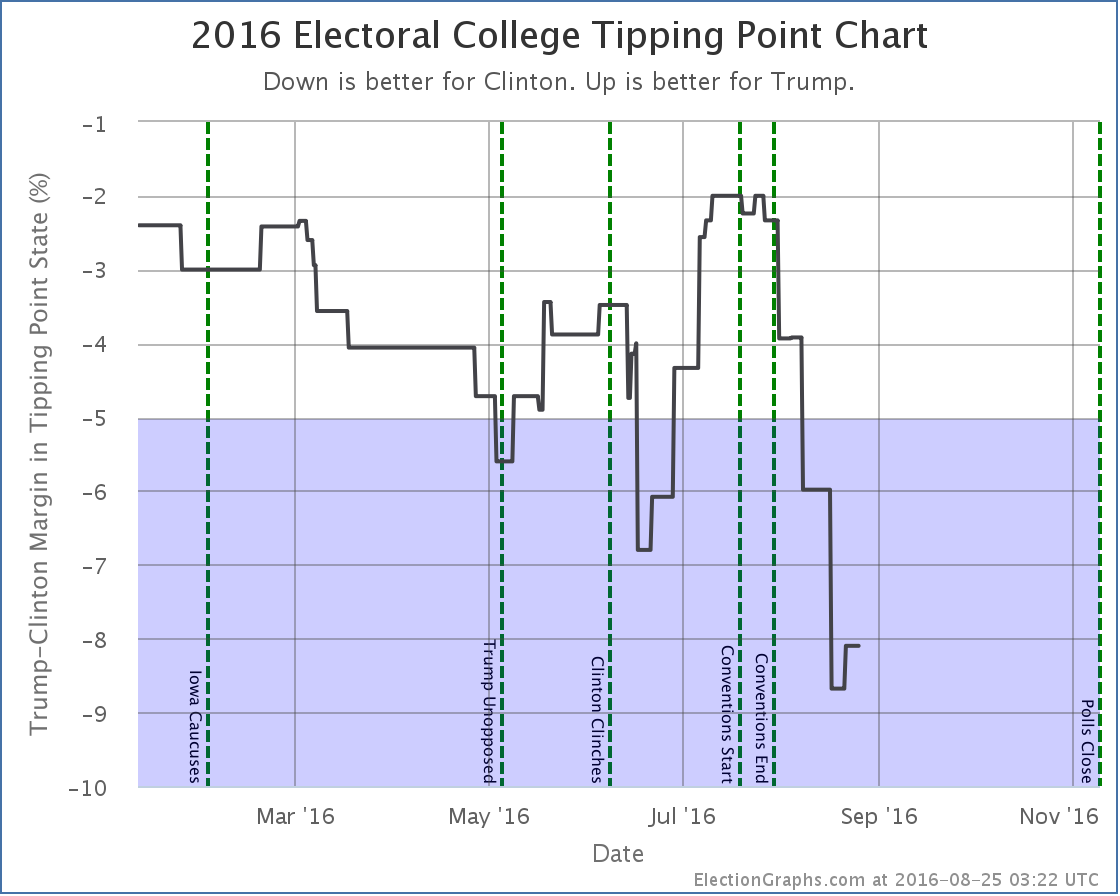
There were actually two Florida polls in today’s update, the second one was more favorable to Trump, so you see above that the tipping point actually dipped down as far as a 8.7% Clinton lead before bouncing back to 8.1%.
The tipping point can be thought of as how much the polls in every state would have to move (if they all moved together) to flip the winner of the race. It is essentially the equivalent of looking at the national popular vote margin, but adjusted to take into account the structure of the electoral college. The downward trend here is brutal for Trump.
The center of the spectrum of states now looks like this:
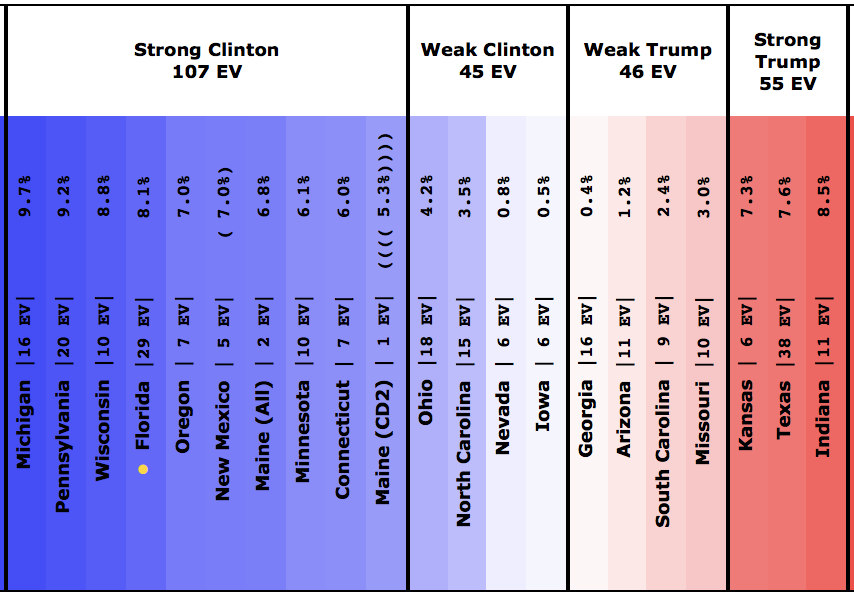
And the overall summary like this:
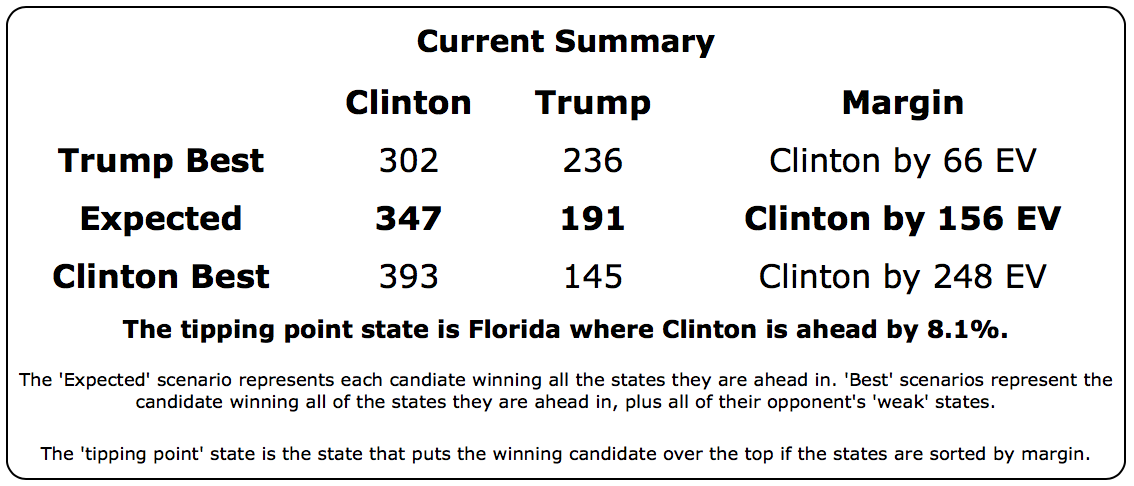
Even if you give Trump all of the close states, he still loses by 66 electoral votes.
Trump is currently losing, and losing badly. Even if he managed movement along the lines of what he saw from mid-June until the conventions, it would only get him back to having a narrow win in his best case scenario. He would still have quite some way to go in order to actually lead.
Things do happen in campaigns, but a comeback from this far behind would take an absolutely seismic change in how this campaign is going… and there are only 75.7 days left.
Notice on Methodology: In my August 13th update I solicited opinions on possibly changing how this site deals with the case when a pollster releases multiple results from a single poll. See the discussion in that comment thread for more details. I’ve concluded that I do want to make a change to re-weight those cases, so that if two results are released from a poll, each counts as only half a poll for purposes of the averages here. I am going to try to adjust the site this coming weekend to make this change. Although the overall picture will remain similar, some states will “jiggle”. For instance, with the current method the average in South Carolina is a 2.4% Trump lead. The drop to that level was one of the items highlighted in today’s post. But the five poll average includes 2 results from a Feldman poll and 2 from a Gravis poll. If the average was calculated in the proposed new way South Carolina would show a 5.4% Trump lead. So it would move back to being “Strong Trump” rather than “Weak Trump” because there would be less weight on the post-convention polls showing a close race, and two additional older polls showing a strong Trump lead would be included in the average. If all goes well, I’ll make a post about the new methodology and any resulting changes to the classifications of the states and such after the surgery on the site is complete. If my changes fail, I’ll roll things back and try again another weekend. :-)
Note: This post is an update based on the data on ElectionGraphs.com. Election Graphs tracks both a poll based estimate of the Electoral College and a numbers based look at the Delegate Races. All of the charts and graphs seen in this post are from that site. Additional graphs, charts and raw data can be found there. Follow @ElectionGraphs on Twitter or like Election Graphs on Facebook to see announcements of updates or to join the conversation. For those interested in individual general election poll updates, follow @ElecCollPolls on Twitter for all the polls as they are added. If you find the information in these posts interesting or useful, please consider visiting the tip jar.
States with new poll data since the last update: Georgia, Nevada
For the first time this month, we have a categorization change that goes in Trump’s direction. This time it is in Georgia:
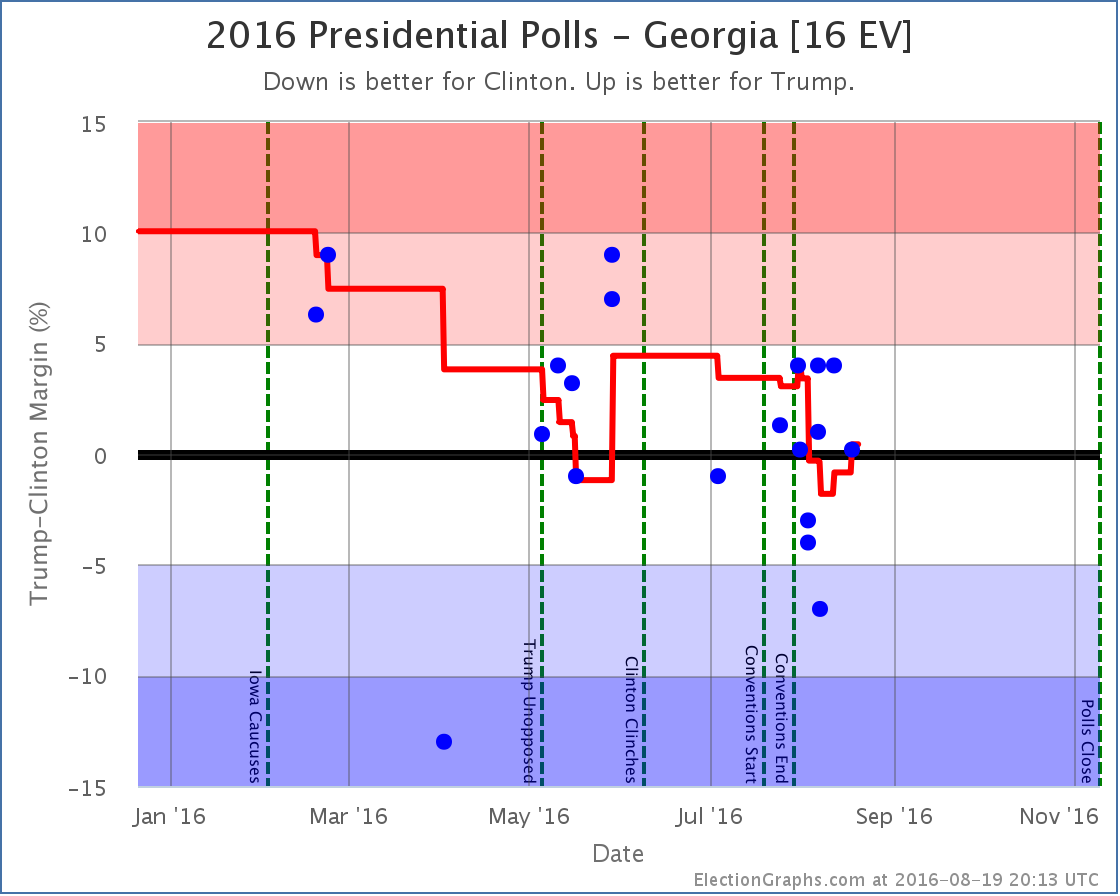
With new polling, two of the three results showing a Clinton lead in Georgia roll off the average, replaced by results showing Trump ahead. The average in the state moves to a 0.4% Trump lead. This is an incredibly narrow lead. Georgia really could go either way. But for the moment, Georgia is once again on the more familiar red side of the center line.
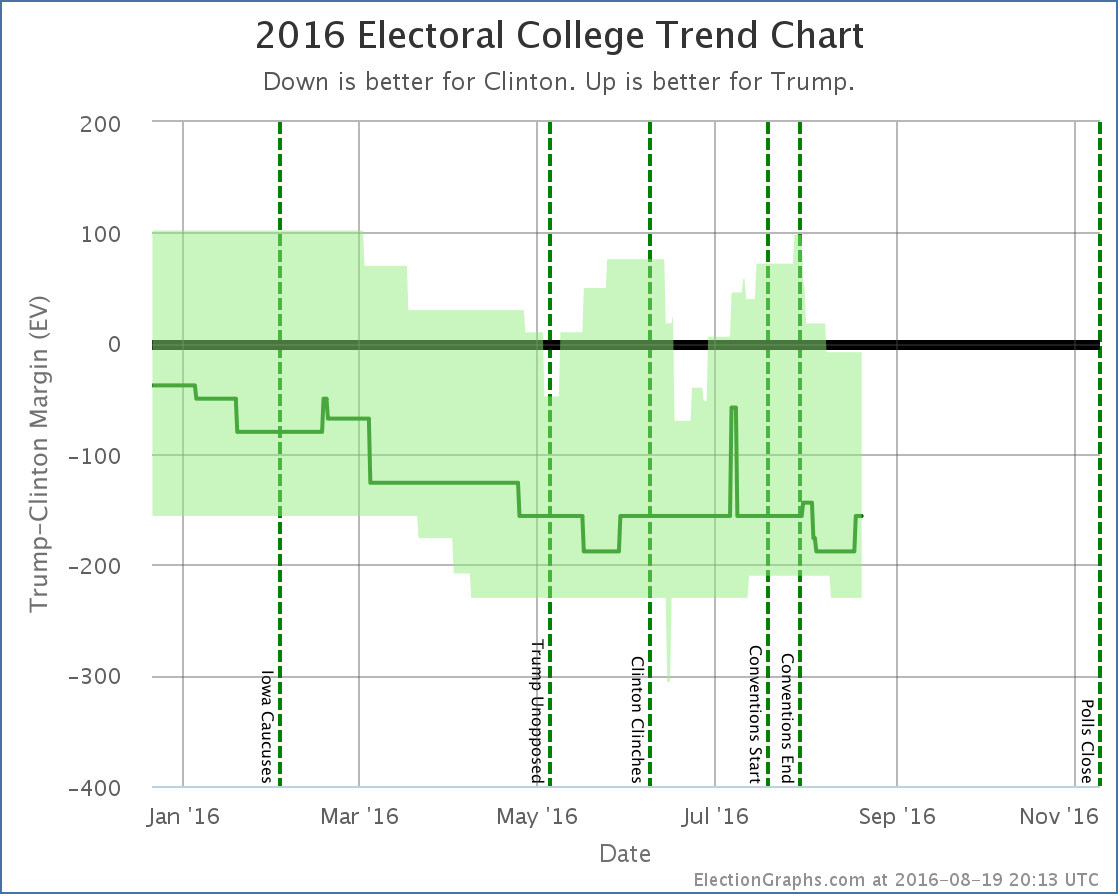
With this, the “expected” result, where each candidate just wins all the states they are ahead in, returns to Clinton 347 to Trump 191, a 156 electoral vote win for Clinton. Still clearly in the zone where Trump does better than McCain (192 electoral vote loss) but worse than Romney (126 electoral vote loss).
Does this indicate Trump has bottomed and is now on the rebound? Well… Georgia is a state that has looked close for months. The polls bounce around quite a bit. A move from a 0.8% Clinton lead to a 0.4% Trump lead may not be super significant. It may flip back with the very next poll. So as usual, use caution in interpreting a move like this. If it is followed up by more good news for Trump, then we can start talking about a Trump rebound. For now, that is still premature.
81.1 days left until the polls start to close.
Note: This post is an update based on the data on ElectionGraphs.com. Election Graphs tracks both a poll based estimate of the Electoral College and a numbers based look at the Delegate Races. All of the charts and graphs seen in this post are from that site. Additional graphs, charts and raw data can be found there. Follow @ElectionGraphs on Twitter or like Election Graphs on Facebook to see announcements of updates or to join the conversation. For those interested in individual general election poll updates, follow @ElecCollPolls on Twitter for all the polls as they are added. If you find the information in these posts interesting or useful, please consider visiting the tip jar.
States with new poll data since the last update: New Hampshire, Georgia, Florida, Indiana, Texas, Virginia, Washington, New York, Michigan, Missouri, Colorado, Iowa, Mississippi
The Trump deterioration continues. This time in the form of weakening in Missouri:
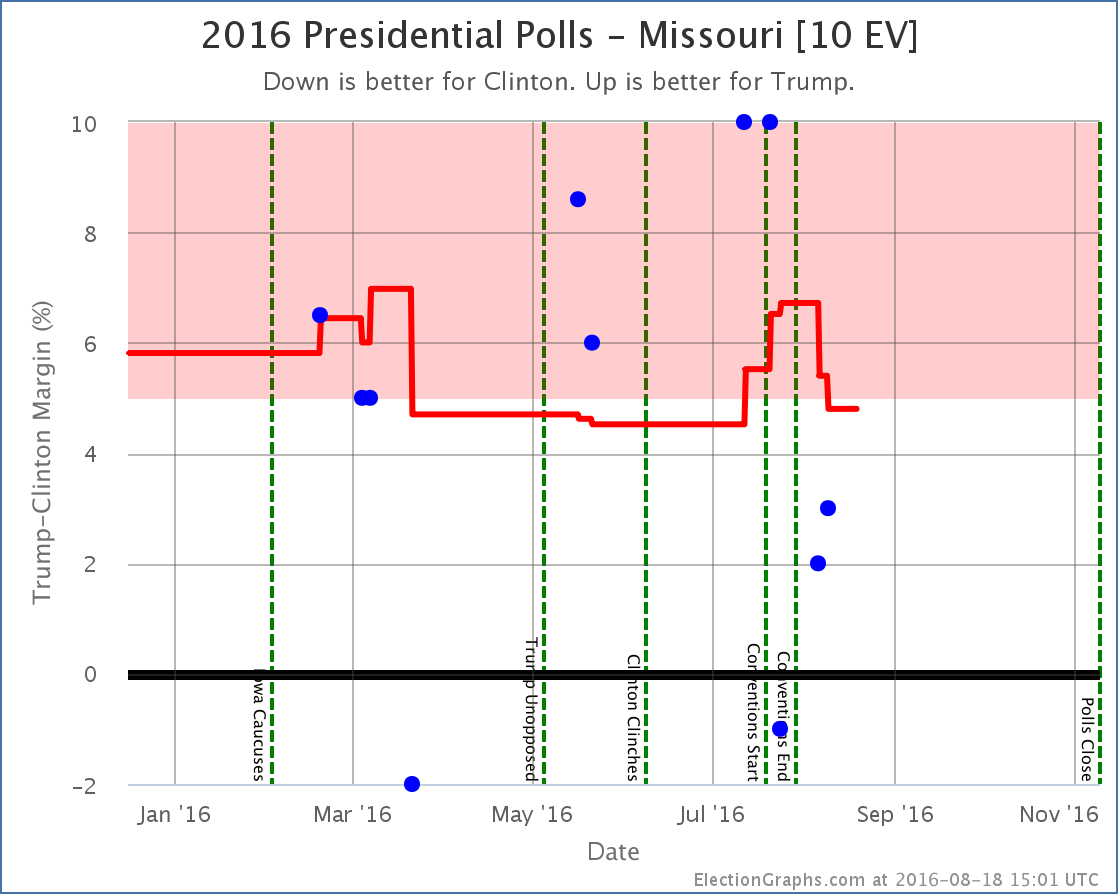
The range in Missouri results is large in the 1.2 months of polling currently used in the average… from Trump up by 10%, to Clinton up by 1%. But the last four polls before the end of the Republican convention all showed Trump up by more than 5%. The three polls taken after the Republican convention ended have all been worse for Trump.
So Trump’s lead in the poll average drops to 4.8%, and Missouri moves from “Strong Trump” to “Weak Trump”. Trump is still ahead, but it is now close enough that we allow the possibility of Clinton winning Missouri in her “best case”.
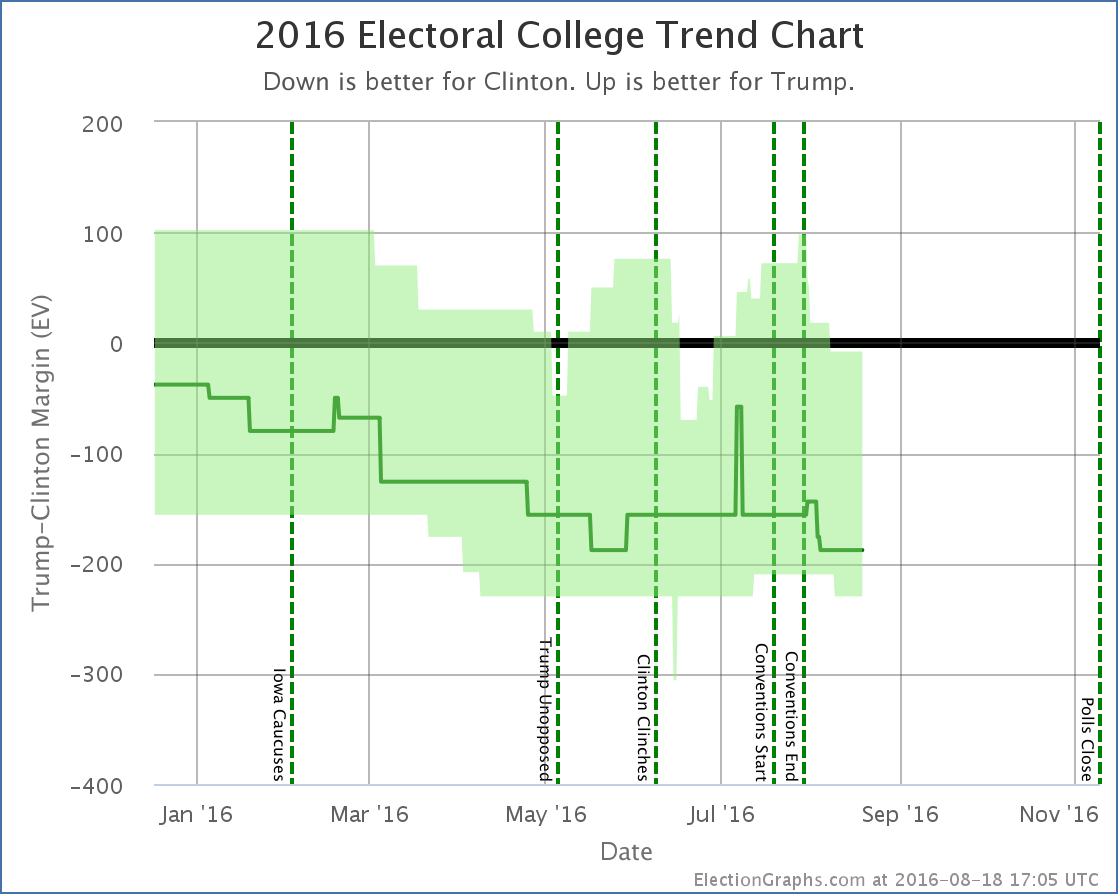
Clinton’s best case is now to win 384 to 154, a 230 electoral vote margin. This is the best number Clinton has seen on this metric aside from a two day period in June where Texas looked close for a moment.
Trump may stop sliding in the polls, or maybe even reverse the trend, but we’re not seeing that yet. For the moment, his collapse continues.
82.3 days until polls start to close on election day.
Note: This post is an update based on the data on ElectionGraphs.com. Election Graphs tracks both a poll based estimate of the Electoral College and a numbers based look at the Delegate Races. All of the charts and graphs seen in this post are from that site. Additional graphs, charts and raw data can be found there. Follow @ElectionGraphs on Twitter or like Election Graphs on Facebook to see announcements of updates or to join the conversation. For those interested in individual general election poll updates, follow @ElecCollPolls on Twitter for all the polls as they are added. If you find the information in these posts interesting or useful, please consider visiting the tip jar.
States with new poll data since the last update: Utah, Georgia, Missouri, Kentucky, Illinois, Pennsylvania, North Carolina, Ohio, Iowa, Florida, Kansas, Wisconsin, New Hampshire, Texas, South Carolina, Maine (All), New York, North Carolina, Virginia, Colorado
There have been tons of polls lately, but most of them didn’t cause any change to the analysis here. The exception this time was Virginia:
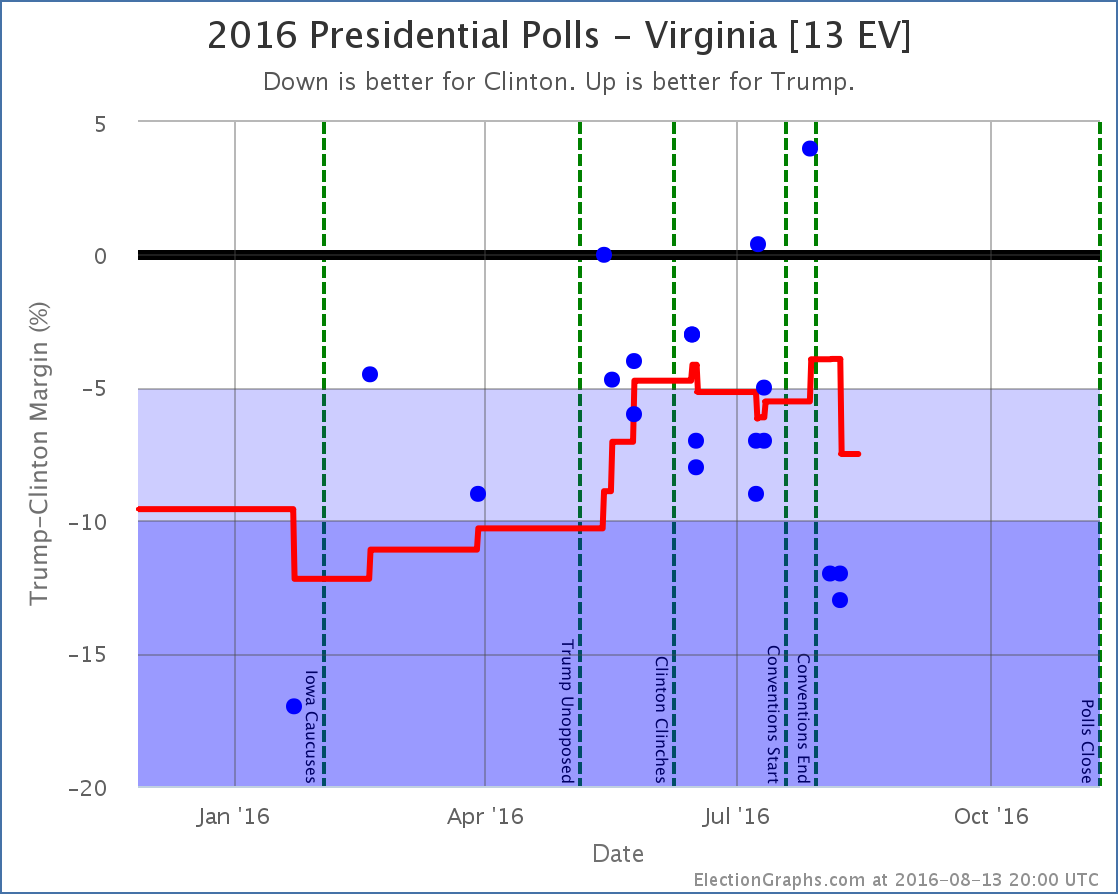
Virginia had been hovering at just about the 5% Clinton lead line since May. A poll taken during the convention weeks gave Trump his biggest lead ever in Virginia. This put Virginia on the close state list. Post convention though, both Marist and YouGov polls have shown Clinton with double digit leads. This moves the average from a 3.9% Clinton lead to a 7.5% Clinton lead.
And so Virginia disappears from Trump’s “best case” where we assume he wins not only the states he leads, but also steals all the states where Clinton’s lead is under 5%.
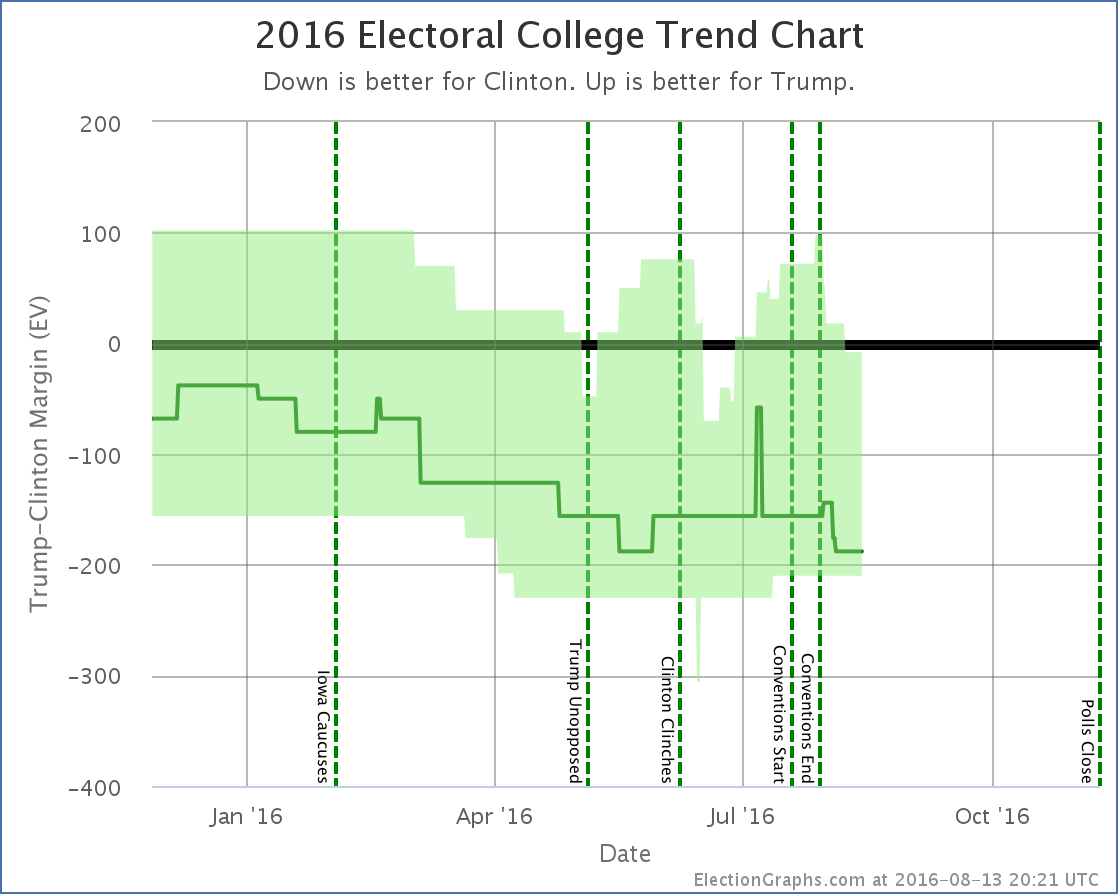
Trump’s “best case” is now to lose to Clinton by 8 electoral votes. A narrow loss, but a loss none the less. To win, Trump not only has to pull all the close states to his side, he has to start winning in some states where Clinton has a substantial lead at the moment.
This is even more striking on the chart of the tipping point. Virginia was the tipping point, and when Clinton’s lead there moved, the tipping point also moved dramatically.
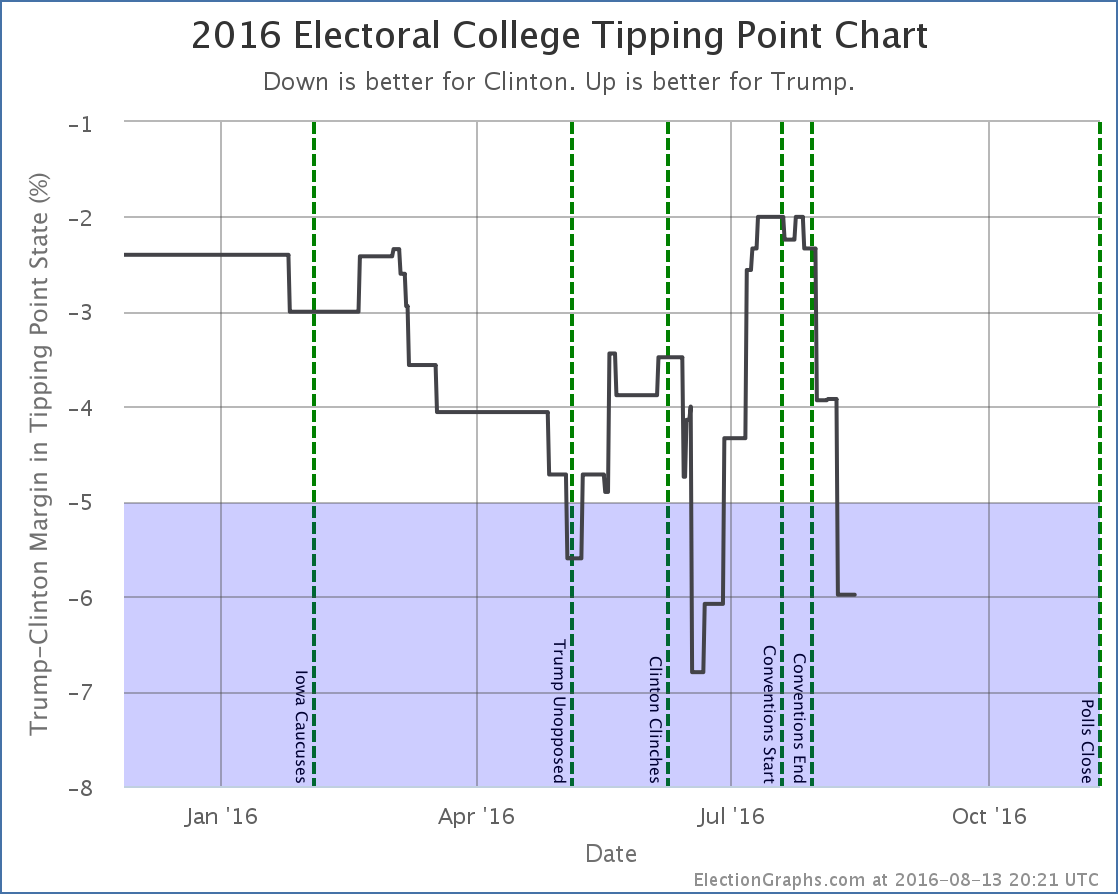
The tipping point moves from Clinton +3.9% in Virginia to Clinton +6.0% in Connecticut. Connecticut! We have a situation where it might be CONNECTICUT that puts Clinton over the edge. Not Ohio, not Florida, not any other traditional swing state… but Connecticut. Clinton’s tipping point lead still isn’t as good as it was back in mid-June, but it is getting close.
The center of the spectrum of states now looks like this:
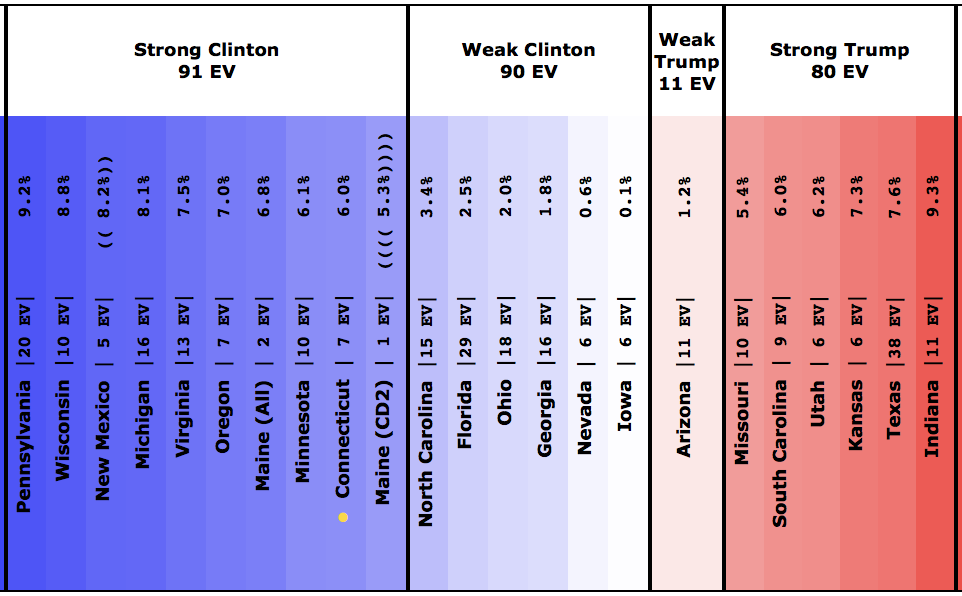
And the national summary like this:
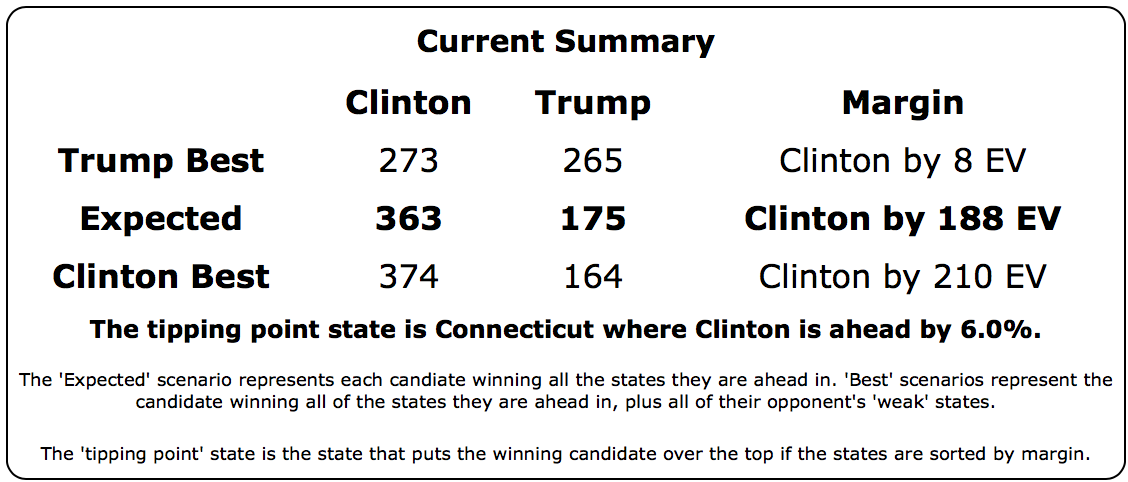
This isn’t a Clinton landslide, but it is looking like a very solid Clinton win. Trump needs to reverse his slide to get back in the game. Let alone to win. So far Election Graphs has NEVER shown a Trump win as the expected result, and right now isn’t even showing Trump in serious contention.
But the graphs above do show that things can swing quickly based on what is happening in the campaign and in the world. So we of course all have to keep watching. 87.1 days until polls start to close.
Opinions Wanted! For the data geeks out there, I’ve been having discussions with a few readers about how I handle it when a single pollster releases multiple results. For instance, in the case above, Marist took one poll, but asked about both Clinton vs Trump (Clinton leads by 13%), and Clinton vs Trump vs Johnson vs Stein (Clinton leads by 12%). Currently, in the interest of keeping things as simple as possible, and also of including everything, I just include both of these data points as if they were completely separate. Of course they are not. The same people were asked both questions. They are not independent results, and are usually closely grouped. So I’m in effect double weighting Marist compared to YouGov, who only released one result (Clinton vs Trump vs Johnson in this case). This also makes my normal “five poll average” often include less than five separate pollsters and cover a smaller time period than it would otherwise. Most other sites in these cases pick ONE of the reported results and ignore the others completely. There are other possible ways to handle this as well. I’m considering if I should make changes to how polls are counted on Election Graphs to address this concern, and if so which changes. If you have an opinion, please let me know in the comments or email me directly at abulsme@abulsme.com. Thanks!
Note: This post is an update based on the data on ElectionGraphs.com. Election Graphs tracks both a poll based estimate of the Electoral College and a numbers based look at the Delegate Races. All of the charts and graphs seen in this post are from that site. Additional graphs, charts and raw data can be found there. Follow @ElectionGraphs on Twitter or like Election Graphs on Facebook to see announcements of updates or to join the conversation. For those interested in individual general election poll updates, follow @ElecCollPolls on Twitter for all the polls as they are added. If you find the information in these posts interesting or useful, please consider visiting the tip jar.
|
|











































